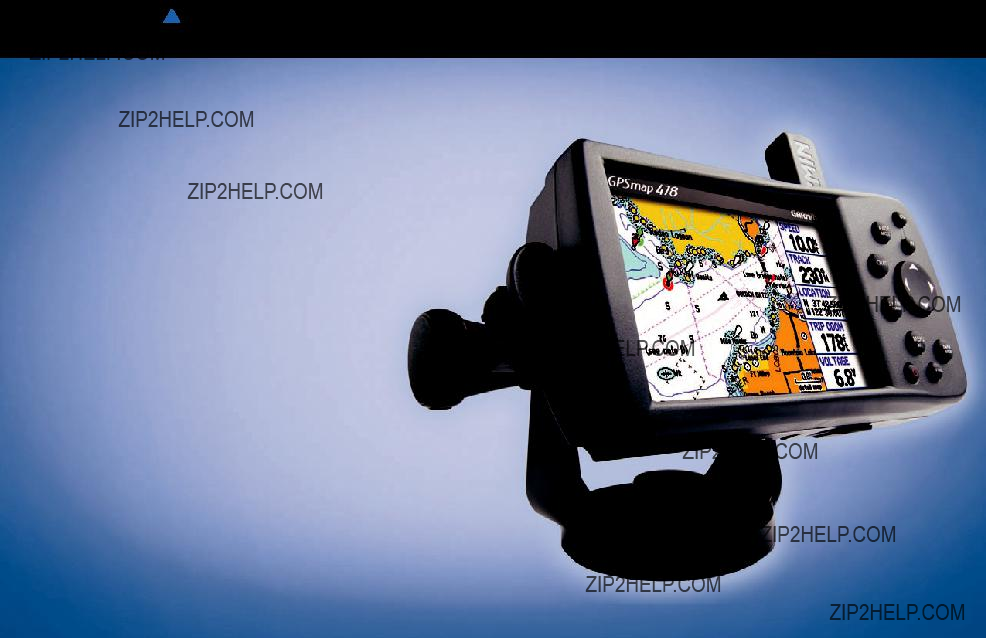
Owner???s Manual
GPSMAP 378/478
chartplotting receiver
GPSMAP 478 shown

Owner???s Manual
GPSMAP 378/478
chartplotting receiver
GPSMAP 478 shown
All rights reserved. Except as expressly provided herein, no part of this manual may be reproduced, copied, transmitted, disseminated, downloaded or stored in any storage medium, for any purpose without the express prior written consent of Garmin. Garmin hereby grants permission to download a single copy of this manual onto a hard drive or other electronic storage medium to be viewed and to print one copy of this manual or of any revision hereto, provided that such electronic or printed copy of this manual must contain the complete text of this copyright notice and provided further that any unauthorized commercial distribution of this manual or any revision hereto is strictly prohibited.
Information in this document is subject to change without notice. Garmin reserves the right to change or improve its products and to make changes in the content without obligation to notify any person or organization of such changes or improvements. Visit the Garmin Web site (www.garmin.com) for current updates and supplemental information concerning the use and operation of this and other Garmin products.
Garmin??, the Garmin logo, AutoLocate??, TracBack??, BlueChart??, City Select??, MapSource??, and

Introduction > About This Manual
Introduction
Thank you for choosing the Garmin?? GPSMAP?? 378/478, which utilizes the proven performance of Garmin GPS and
About This Manual
To get the most out of your new navigation system, take time to read this manual and learn the operating procedures for your unit. This manual is organized into the following sections:
The Introduction contains the Table of Contents, Care Information, and Warnings.
The Getting Started section provides an overview of the unit, how to turn the unit on, and how to simulate navigation.
The Marine Mode section provides you with information about navigating with the GPSMAP 378/478 in Marine Mode.
The Marine Mode Pages section reviews the main pages in Marine Mode.
The Automotive Mode section provides you with information about navigating with the GPSMAP 378/478 in Automotive Mode.
The Automotive Mode Pages section reviews the main pages in Automotive Mode.
The Main Menu section describes features found on the Main Menu, and information on how to change settings.
The Using XM WX Weather section describes how to use XM WX Satellite Weather features on your GPSMAP 378/478.
The Setting Up and Using Sonar section provides instructions on using a Garmin GSD 20 or GSD 21 Sounder Module with your GPSMAP 378/478.
The Appendix contains specifications, optional accessories, maintenance information, and other product information.
An Index is provided at the end of the manual for reference.

Introduction > Table of Contents

Introduction > Table of Contents

Introduction > Caring for the GPSMAP 378/478
Caring for the GPSMAP 378/478
The GPSMAP 378/478 case is constructed of high quality materials and does not require user maintenance except cleaning.
Cleaning the Case
Clean the unit???s outer casing (except for the screen) using a cloth dampened with a mild detergent solution and then wipe dry. Avoid chemical cleaners and solvents that might damage plastic components.
Cleaning the Screen
The GPSMAP 378/478 screen should be cleaned using a soft, clean,
Storage
Do not store the GPSMAP 378/478 where prolonged exposure to temperature extremes might occur (such as in the trunk of a car) as permanent damage could result. User information, such as waypoints and routes, is retained in the unit???s memory without the need for external power. It is always a good practice to back up important user data by manually recording it or downloading it to a computer (transferring it to MapSource).
Water Immersion
The GPSMAP 378/478 is waterproof to IEC Standard
60529 IPX7. It can withstand immersion in 1 meter of water for 30 minutes. Prolonged submersion can cause damage to the unit. After submersion, be certain to wipe and air dry the unit before reuse or charging.

Introduction > Warnings
 Warnings
Warnings
Failure to avoid the following potentially hazardous situations could result in an accident or collision resulting in death or serious injury.
???When installing the unit in a vehicle, place the unit securely so that it does not obstruct the driver???s view of the road or interfere with vehicle operating controls, such as the steering wheel, foot pedals, or transmission levers. Do not place in front of or above any airbag. (See diagram.)
Do not mount in front of an airbag field of deployment.
???When navigating, carefully compare information displayed on the unit to all available navigation sources, including information from street signs, visual sightings, and maps. For safety, always resolve any discrepancies or questions before continuing navigation and defer to posted road signs.
???Always operate the vehicle in a safe manner. Do not become distracted by the unit while driving, and always be fully aware of all driving conditions. Minimize the amount of time spent viewing the unit???s screen while driving and use voice prompts when possible. Do not input destinations, change settings, or access any functions requiring prolonged use of the unit???s controls while driving. Pull over in a safe and legal manner before attempting such operations.
???This unit is designed to provide route suggestions. It is not designed to replace the need for driver attentiveness regarding road closures or road conditions, traffic congestion, weather conditions, or other factors that may affect safety while driving.
???Use the electronic chart in the unit only to facilitate, not to replace, the use of authorized government charts. Official government charts and notices to mariners contain all information needed to navigate safely.
???Use this unit only as a navigational aid. Do not attempt to use the unit for any purpose requiring precise measurement of direction, distance, location, or topography.
WARNING: This product, its packaging, and its components contain chemicals known to the State of California to cause cancer, birth defects, or reproductive harm. This Notice is provided in accordance with California???s Proposition 65. See www.garmin.com/prop65 for more information.

Introduction > Important Information and Battery Warnings
Important Information
MAP DATA INFORMATION: One of the goals of Garmin is to provide customers with the most complete and accurate cartography that is available to us at a reasonable cost. We use a combination of governmental and private data sources, which we identify in product literature and copyright messages displayed to the consumer. Virtually all data sources contain some inaccurate or incomplete data. In some countries, complete and accurate map information is either not available or is prohibitively expensive.
NOTICE REGARDING WINDSHIELD MOUNTING; SPECIAL NOTICE TO DRIVERS IN CALIFORNIAAND MINNESOTA: State law prohibits drivers in California and Minnesota from using suction mounts on their windshields while operating motor vehicles. Check your state and local laws and ordinances for similar restrictions. Other Garmin dashboard or friction mounting options should be used. Garmin does not take any responsibility for any ???ines, penalties, or damages that may be incurred as a result of disregarding this notice or as a result of any other state or local law or ordinance relating
to use of the unit. (See California Vehicle Code Section 26708(a); Minnesota Statutes 2005, Section 169.71.)
The California Electronic Waste Recycling Act of 2003 requires the recycling of certain electronics. For more information on the applicability to this product, see www.erecycle.org.
Battery Warnings
If these guidelines are not followed, the internal
???Do not leave the unit exposed to a heat source or in a high temperature location, such as in the sun in an unattended vehicle. To prevent damage, remove the unit from the vehicle or store it out of direct sunlight, such as in the glove box.
???Do not puncture or incinerate.
???When storing the unit for an extended time, store within the following temperature range: 32?? to 77??F (0?? to 25??C).
???Do not operate the unit outside of the following temperature range:
???Contact your local waste disposal department to properly recycle/ dispose of the unit/battery.
Additional
???Do not use a sharp object to remove the battery.
???Keep the battery away from children.
???Do not disassemble, puncture, or damage the battery.
???If using an external battery charger, only use the Garmin accessory approved for your product.
???Only replace the battery with the correct replacement battery. Using another battery presents a risk of fire or explosion. To purchase a replacement battery, see your Garmin dealer or the Garmin Web site.
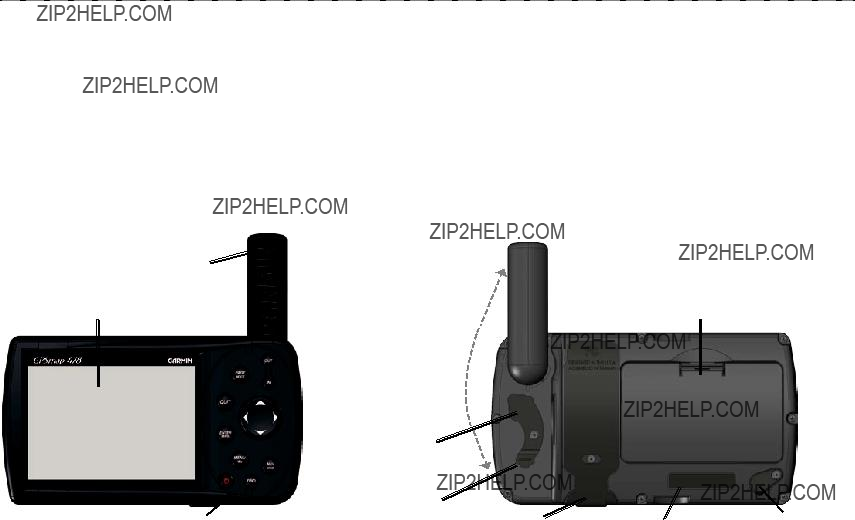
Getting Started > Unit Overview
Getting Started
Unit Overview
The GPSMAP 378/478 is an
With the optional GXM 30 antenna and a subscription to XM WX Satellite Weather, users have constant access to NEXRAD radar, lightning, wind speed, wave direction, and more. In addition, the GPSMAP 378/478 offers XM Satellite Radio capabilities featuring more than 160 digital channels of
GPS antenna
Backlit keypad for easy nighttime operation
Detachable GPS antenna collapses for storage.
Be sure the antenna is up (as shown here) to receive satellite signals. See the
???Appendix???, page 122, for instructions on removing the antenna. External power connector under weather cap
USB/GXM 30 antenna connector under weather cap
Battery pack. Press tab down to remove battery pack for replacement, if necessary.
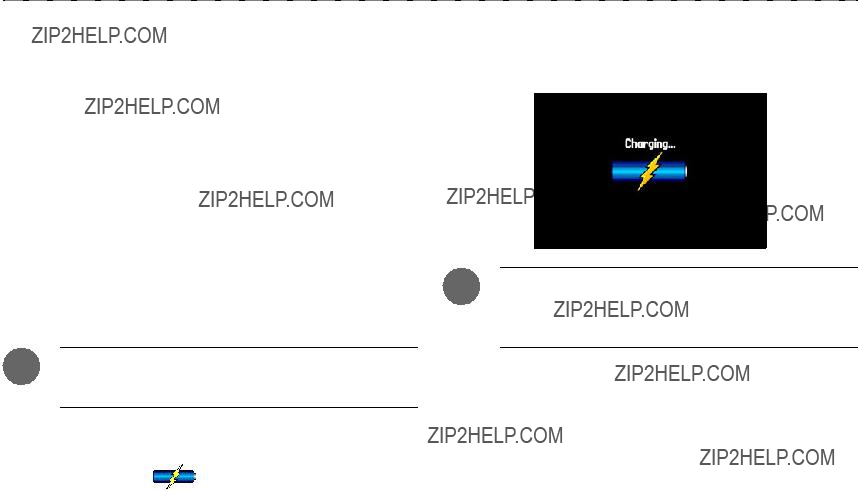
Getting Started > Charging the GPSMAP 378/478
Charging the GPSMAP 378/478
Before using the GPSMAP 378/478, you might need to charge the battery. Plug the power cable into an external power source to charge. You can use the unit while it is charging.
To charge the unit???s battery:
1.Lift the rubber weather cap to expose the power connector on the back of the unit. See the image on page 1 for connector location.
2.Align the notches and push the plug into the connector until fully seated.
3.Plug the
TIP: Placing the unit in Charge Mode charges the unit more quickly than when the unit is turned on, and reduces draw on the vehicle/vessel battery.
When you turn on the GPSMAP 376C the power source indicator on the GPS tab shows the unit is operating off battery power ( ), that the unit is charging ( ), or that an external power source is in use (
), that the unit is charging ( ), or that an external power source is in use ( ).
).
Using Charge Mode
If you want to charge the battery when you are not using the unit, you can put the unit into Charge Mode.
Note: While in Charge Mode, the GPSMAP 378/478 draws a small amount of current from the vessel/vehicle battery. To avoid discharging the vehicle???s battery, disconnect the external power cable from the unit when not in use for several days.
Over time, you might notice that the
GPSMAP 378/478 Owner???s Manual

Getting Started > Turning On the GPSMAP 378/478
Turning On the GPSMAP 378/478
Before you turn on the GPSMAP 378/478, be sure the antenna is up as shown on page 1, and it has a clear and unobstructed view of the sky to receive satellite signals.
The first time you turn on your GPSMAP 378/478, the GPS receiver must collect satellite data and establish its current location. To ensure proper initialization, the GPSMAP 378/478 is shipped from the factory in AutoLocate Mode, which allows the receiver to ???find itself??? anywhere in the world.
To turn the GPSMAP 378/478 on and off:
1.Press and hold the Power key. When the unit turns on, a tone sounds and the Warning Page opens.
Warning Page
2.Read the warning, and then press Enter to continue.
3.To turn off the GPSMAP 378/478, press and hold the POWER key again.
Adjusting the Backlight and Volume
You can adjust the backlight to see the screen better. If you are using the external speaker with
headphone jack, you can adjust the volume level of the audio output.
To adjust the backlight level or volume:
1.Press and quickly release the POWER key.
2.Press up on the ROCKER to increase the brightness or press down to decrease. Press right to raise the volume or left to lower.
3.Press Enter or Quit to close the Backlight/Volume adjustment window.
Battery time remaining and power source indicator

Getting Started > Getting Satellite Signals
Getting Satellite Signals
After you turn on the GPSMAP 378/478, the unit automatically begins searching for satellites. The GPS Page appears while the unit is gathering satellite signals and acquiring a fix, which should take only a few minutes. While the GPSMAP 378/478 is getting satellite signals, the GPS Page shows the status as ???Acquiring Satellites.???
GPS Tab
Note: While acquiring satellites, the Map Page might show the wrong location, such as China. You need to wait a few more minutes to acquire satellites and find your current location.
Viewing GPS Status with the GPS Tab
The GPS tab provides a visual reference of satellite acquisition, receiver status, and accuracy. The sky view and signal strength bars show what satellites are visible to the receiver and whether they are being tracked.
As the receiver locks onto satellites, a signal strength bar appears for each satellite in view, with the appropriate satellite number underneath each bar. The numbers below each bar represent the particular satellite that is being received. Numbers above 33 indicate WAAS satellites.
The sky view shows a bird???s eye view of the position of each satellite relative to the receiver???s last known position. The outer circle represents the horizon (north up), the inner circle represents 45?? above the horizon, and the center point represents a position directly overhead. You can also set the sky view to a Track Up configuration, causing the top of the sky view to align along your current track heading. Press Menu to change the configuration of the sky view.
Sky view 
Power source indicator
GPS Page
GPSMAP 378/478 Owner???s Manual

Getting Started > Getting Satellite Signals
The progress of satellite acquisition is shown in three stages:
???No signal strength
???White signal strength
???Green signal strength
When the GPSMAP 378/478 collects the necessary data from the best satellites in view to calculate a fix, the status field indicates the status of the receiver. The unit then updates the location, date and time.
Receiver Status
The Receiver Status field shows one of the following conditions:
???Searching the
???
???Acquiring
???2D GPS
???2D Differential??? appears when you are receiving DGPS corrections in 2D mode, and a ???D??? appears on the strength bar of satellites being corrected.
???3D GPS
3D mode, and a ???D??? appears on the strength bar of satellites being corrected.
???Lost Satellite
???Receiver Not
???Simulating
???GPS

Getting Started > Getting Satellite Signals
GPS Options
Press Menu twice to open the Main Menu. Use the ROCKER to highlight the GPS tab. Press Menu to open the options menu.
Start/Stop
Enable/Disable
Track Up Skyview/North Up
New
New
GPS Tips
While the receiver is gathering information, your location on the map might appear different from where you are actually located. As soon as the receiver gathers enough satellite information, your proper location appears on the map.
Any time you have traveled more than 600 miles with the GPS receiver turned off, the receiver might take longer than normal to initialize and find your location.
The GPS receiver can lose satellite signals due to interference from such items as buildings, tunnels, and heavy tree cover. Monitoring the GPS status is recommended.
To learn about GPS, visit www.garmin.com/aboutGPS/.
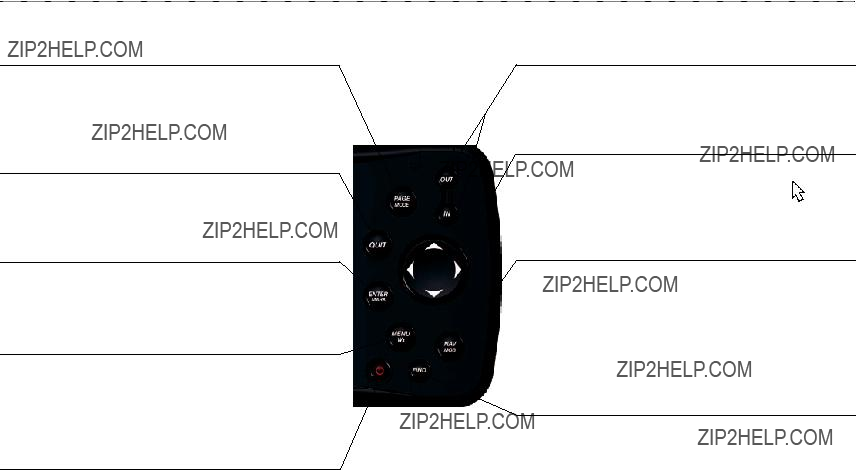
Getting Started > Using the GPSMAP 378/478 Keypad
Using the GPSMAP 378/478 Keypad
.PAGE/MODE Key
???Press to cycle through main pages in sequence and exit a submenu page.
???Press and hold to switch between Marine and Automotive Modes.
QUIT Key
???Press to cycle through main pages in reverse sequence, revert to the previous value in a data entry field, or cancel an unintended function.
ENTER/MARK Key
??? Press to select a highlighted option.
???Press and hold to mark your current location as a waypoint.
MENU/Wx Key
???Press to open the options menu for the current page.
???Press twice to show the Main Menu.
???Press and hold to toggle XM WX weather on or off on the Map Page.
POWER Key
???Press and hold to turn the unit on or off.
???Press and release to adjust the backlighting and external speaker volume.
IN Key/OUT Key
???Press to adjust map scale to show a larger area with less detail (zoom out) or a smaller area with more detail (zoom in).
ROCKER
??? Press up, down, left, or right to highlight options and to enter data, or use to pan the arrow on the Map Page.
NAV/MOB Key
???Press to show the Navigate Menu.
???In Marine Mode, press and hold to start the MOB function.
In Automotive Mode, press and hold to show the Next Turn page and announce the next turn when using the external speaker.
FIND Key
???Press to quickly search for and access user waypoints, cities, and other items used for navigation.

Getting Started > Using the GPSMAP 378/478
Using the GPSMAP 378/478
The advanced keypad system on the GSPMAP 378/478 is designed to allow you to select options and enter data quickly and conveniently. As you progress through this owner???s manual, you are directed to press a specific key or highlight a field on the screen.
When you are directed to press a key, you should press and quickly release the key. If the key needs to be held down for a period of time to start a secondary function, the instructions will tell you to do so.
When a field is selected on the screen, it is highlighted in yellow.
The following terms are used throughout this manual:
???
???
ROCKER to begin entering data or selecting options.
???
???Scroll
ROCKER.
???
 Field
Field
Cartography
The GPSMAP 378 system contains preloaded U.S. inland freshwater cartography to its enhanced worldwide basemap information.
The preloaded inland maps offer
The GPSMAP 478 system contains preloaded marine map detail utilizing BlueChart?? g2 technology. Coverage is for US coastal areas.
GPSMAP 378/478 Owner???s Manual

Getting Started > Using the GPSMAP 378/478
Selecting Options and Entering Data
To enter data and select options use the ROCKER to highlight, select, or choose an item in a list or a field on the screen. Use the
Enter key and the ROCKER to select options, enter names and numbers in data fields, and activate your selections.
To select and activate an option:
1.From any page, press Menu. An options menu shows a list of optional features to that page.
To exit a menu or return to the previous setting:
Press Quit. The Quit key moves backward through your steps. Press Quit repeatedly to return to the starting page.
To select an
On a page with
button
2.Use the ROCKER to move the highlight up, down, right, or left on the menu to the option you want to select.
3.Press Enter to select the feature. Another window with more options might appear. If so, select an option and press Enter again.
To mark your current location as a waypoint, press and hold Enter/Mark until the New Waypoint Page opens.
To enter data in a data field:
1.Use the ROCKER to highlight the data field you want, and press Enter to edit it.
2.Press up or down on the ROCKER to select characters. Press right to move to the next character or press left to move back to the previous character. If there are two lines of data, keep pressing right on the ROCKER to drop to the next line.

Getting Started > Using the GPSMAP 378/478
Entering
data
TIP: To clear the entire data field, highlight the
3. Press Enter.
Not all fields are programmable. When you are on a page with fields that are not selectable, the highlight skips over them.
Restoring Default Settings
You can restore factory defaults for the following Main Menu tabs: Track, Alarms, Display, Sound, and Setup. For more information about the Main Menu, see the ???Main Menu??? section beginning on page 67.
To restore default settings:
1.Press Menu twice to open the Main Menu.
2.Use the ROCKER to highlight a tab, and then press MENU to open the options menu.
Setup Tab Options Menu
3. Highlight Restore Default, and press Enter.

Getting Started > Using the GPSMAP 378/478
Using the Main Menu
Use the Main Menu on your GPSMAP 378/478 to access various waypoint, system, navigation and interface management, and setup menus. Press the MENU key twice from any page to open the Main Menu. For more information, see the ???Main Menu??? section on page 67.
Main Menu
To select a tab from the Main Menu:
1.From any page, press MENU twice to open the Main Menu.
2.Press up or down on the ROCKER to highlight a tab. The information for the highlighted tab automatically appears on the right. To highlight a sub tab, press left or right on the ROCKER, and then press up and down to select individual fields.
By default, the Main Menu tabs are shown as icons along the left side of the screen. You can change the Main Menu to show tabs in a
To view the Main Menu icons in
1.Highlight the Display tab, and press ENTER.
2.Select the Main Menu field. Press ENTER.
3.Highlight Text Only, and press ENTER.
Display Tab

Getting Started > Using Simulator Mode
Using Simulator Mode
Simulator Mode is great for practicing with the unit if you are indoors or when satellite signals are not available. All waypoints and routes created in Simulator Mode are retained in memory for future use.
By unplugging the GXM 30 antenna and placing the unit in Simulator Mode, you can view simulated weather information.
NOTE: Do not try to navigate using Simulator Mode. When the unit is set to Simulator Mode, the GPS receiver is turned off. Any satellite signal strength bars shown are only simulations and do not represent the strength of actual satellite signals.
To turn on Simulator Mode:
1.Highlight the GPS tab on the Main Menu.
2.Press Menu to open the GPS tab options menu.
3.Highlight Start Simulator, and press Enter.
GPS tab
Starting Simulator Mode from the GPS tab
Entering a New Location
Use the GPS options menu to enter a new location from which to simulate.
To enter a New Location using the map:
1.Highlight the GPS tab on the Main Menu.
2.Press Menu to open the options menu.
3.Highlight New Location, and press Enter.
4.Highlight Use Map, and press Enter.
5.Use the ROCKER to move the panning arrow to the location you want on the map, and press Enter.
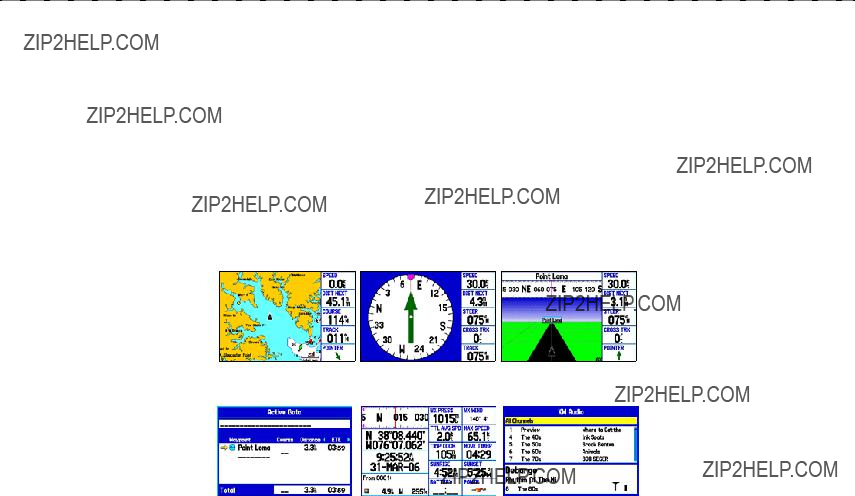
Marine Mode > Marine Mode Pages
Marine Mode
This section explains some of the more common operations you will perform with your GPSMAP 378/478.
To switch usage modes:
1.Press and hold the Page/MODE key. The Usage Mode Menu appears.
2.Use the ROCKER to select either Automotive or Marine, and press Enter.
Marine Mode Pages
Marine Mode has five main pages: Map, Compass, Highway, Active Route, and Position Data. An optional XM Audio Page can be enabled.
An optional Sonar Page is available when a GSD 21 is connected. See the ???Setting Up and Using Sonar??? section beginning on page 103 for more information.
Active Route Page Position Data Page XM Audio Page
(Optional)

Marine Mode > Navigating to a Destination
Navigating to a Destination
You can navigate to your destination using the Map Page. As you travel, you see a magenta line that always runs from your current location to the destination or to the next turn on the Map Page. You can use the Map Page, Compass Page, Highway Page, and Position Data Page to help navigate.
You can navigate to a destination using one of the following methods:
???Select a point on the map and press Nav.
???Press Nav to start a new route using the Find Menu or start a saved route or track.
???Press the Find key to search for a particular item and create a route to it.
Marine Mode and Automotive Mode are similar. Most of the features discussed here also apply to Automotive Mode.
Navigate Options Menu
Press Nav to open the Navigate Menu.
Navigate Menu in Marine Mode
Go To
Navigate
Navigate Track
MOB (Man
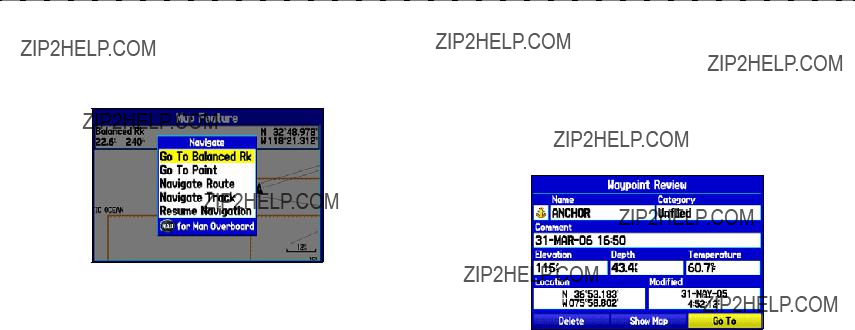
Marine Mode > Navigating to a Destination
To navigate (Go To) a point on the map:
1.On the Map Page, highlight a point to navigate to, and press
NAV.
2.Highlight Go To <point name>, and press ENTER.
Navigate Menu
3. Follow the magenta route created on the Map Page.
To stop navigation:
1.While navigating to a point, press NAV.
2.Highlight Stop Navigation, and press ENTER.
3.Highlight Resume Navigation, and press ENTER to resume navigation.
To start a new route using the Find Menu:
1.Press the Nav key to open the Navigate Menu.
2.Highlight Go To Point (or New Route when in Automotive Mode) and press Enter to open the Find Menu.
3.From the Find Menu, highlight Waypoints and press Enter.
4.Select a waypoint from the list, and press Enter to open the Waypoint Review Page.
Waypoint Review Page
5.With the Go To button highlighted, press Enter to begin navigation.

Marine Mode > Navigating to a Destination
To search for an item and route to it:
1.Press Find to open the Find Menu.
2.Highlight a category, and press Enter.
3.Press Enter and press the ROCKER up or down to enter letters contained in the item name. Press Enter when finished.
Finding an item using the Containing field: The unit searches for items containing the letter combination you enter and shows them in the list.
4.Highlight the item from the list, and press Enter.
5.Press Enter when the Go To button is highlighted.
For complete information about finding an item, see the ???Finding an Item??? section.
Man OverBoard (MOB)
Use the MOB function to simultaneously mark your current location and create a direct route back to that location for quick response to emergency situations.
To start the MOB function:
1.Press and hold the Nav/Mob key, or press the Nav/Mob key twice.
2.Press Enter to confirm and begin navigating to the MOB location.
When a MOB is activated, a MOB waypoint with an international MOB symbol is created, and the unit begins actively navigating to that point. Use any of the navigation pages to guide you back to the MOB point. The MOB waypoint is stored in the waypoint list and can be deleted like any other waypoint.

Marine Mode > Finding an Item
Finding an Item
Use the Find Menu to easily search for addresses, food & drink, fuel services, lodging, banks/ATMs, cities, shopping, stored waypoints and points of interest (POIs). To open the Find Menu, press the
Find key.
The Find Menu is comprised of several default categories: Waypoints, Cities, Exits, Transportation, Tide Stations, and Weather Data. Additional categories appear depending on the optional BlueChart g2 or MapSource data card in the unit.
Find Menu
Follow the directions on page 15 to navigate a new route using the Find Menu.
Using the Find From Feature
You can use the Find Menu to center your search around an item you just found. For example, you search for Restricted Areas and the search shows an ???Anchoring Prohibited??? search result. If you press Find again, you will see ???From Anchoring Prohibited??? as the new search from point. You can also use the Find feature to center your search from any waypoint, route list entry, map item, or tide station.
To find an item from another location on the map:
1Open the Map Page. Use the ROCKER to pan the arrow (pointer) to the location you want, and press Find. The Find Menu opens, showing ???From Map Pointer.??? The list of items is sorted to show items nearest the selected location.
2.Highlight a category from the list, and press Enter.
3.Highlight an item from the list, and press Enter. The item???s Information Page automatically opens, allowing you to save the item as a waypoint, show the item on the map, or automatically create a route to (Go To) the item.

Marine Mode > Finding an Item
To find an item from another location:
1.From any page, press Find.
2.Highlight a category from the list, and press ENTER.
3.Press Menu to open the options menu.
Find From Options Menu
4.Highlight Near Other and press Enter. If you are actively following a route, you can also choose one of the other options listed in the Find From list.
5.Select a reference location on the map, and press Enter. The list shows items nearest to the new map location.
To find an item near another item:
1.Press Find. The Find Menu opens.
2.Highlight the item you want to ???Find From.???
3.Press Find. The Find Menu opens again with items near the
Viewing Recently Found Items
The Recently Found Page shows a list of the items you have searched for or gone to recently.
To view recently found items:
1.Press Find to open the Find Menu.
2.Highlight Recently Found, and press Enter to open the list of recently found items.
3.Press MENU to show the options menu.
4.Select Show Find History to view the list of items you have searched for recently.
5.Highlight Remove Point, and press ENTER to delete the selected recently found point.

Marine Mode > Finding an Item
Viewing the Information Page
Each item on the map and each item listed in the results list has an information page.
To view details about an item:
1.Highlight a point on the map or in the search results list, and press Enter.
An information page appears with details about the item, in a tabbed format. Depending on the type of item, additional options are available for viewing the item on the map, viewing a tide chart, viewing the list of maps on your data card, and viewing the next item in the search results list.
Map Feature Information Page
2.Press Page or Quit to exit the information page. You can also highlight one of the
Enter.
Find Menu Options
To view additional Find Menu options, press Find, and then press Menu. The following options are available:
???Enable Auto
???Near
???Map
Additional selections are included in the options menu when you are navigating:
???Near
???Near
???Near Current

Marine Mode > Creating and Using Routes
Creating and Using Routes
The GPSMAP 378/478 allows you to create and store up to 50 reversible routes, with up to 300 points each.
Creating a New Route
Use the Route tab to create a route by selecting waypoints from the Find Menu, or by selecting waypoints or map items from the Map Page.
To create a route using the Find Menu:
1. Highlight the Route tab on the Main Menu.
Route Tab with the Route List
2.Press Menu to open the Route options menu.
3.Highlight New Route, and press Enter.
4.Press ENTER to find items to add to the route.
5.Highlight OK, and press ENTER to add a route point.
6.Repeat step 5 to define additional route points.
To create a route using the map:
1.Highlight the Route tab on the Main Menu.
2.Press MENU to open the Route options menu.
3.Highlight New Route, and press ENTER.
4.Press MENU to open the options menu.
5.Highlight Edit on Map, and press ENTER.
6.Highlight a location on the map, and press ENTER.
7.Repeat step 5 to define additional route points
NOTE: If you select an area of the map that is not a feature or waypoint, a new waypoint is created for that location. Press ENTER on the New Waypoint Page to save the location as a waypoint and continue adding points to your route. You can edit the properties of this waypoint as you can with any waypoint.

Marine Mode > Creating and Using Routes
Navigating a Saved Route
Use the Navigate Route option to select and navigate a saved route.
To navigate a saved route:
1.Press the Nav key.
2.Highlight Navigate Route, and press Enter.
3.Highlight a route, and press Enter.
Select a route from list
Editing a Route
After you create a route, use the Route Review Page to edit, change the name, and review route points of a selected route.
To change the name of the route:
1.Highlight the Route tab on Main Menu.
2.Highlight the name of the route, and press Enter.
3.With the Route Review Page open, highlight the route name field at the top of the page, and press Enter.
Enter a new Route name here
Route Review Page
4.Use the ROCKER to enter the route name, and press
Enter.
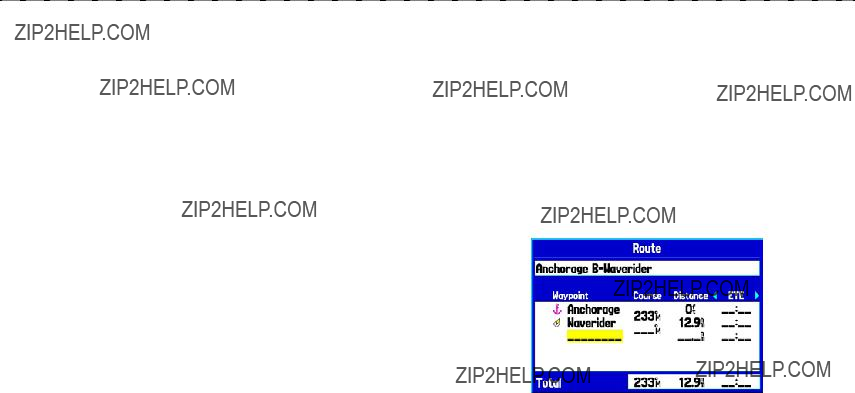
Marine Mode > Creating and Using Routes
To review individual route points:
1.Highlight the Route tab on the Main Menu.
2.From the Route List Page, highlight the name of the route, and press Enter.
3.From the Route Review Page, highlight a point, and press
Enter.
4.On the Point Review Page, choose Next (highlight the next point on the route list), Show Map (show the point on a map window), or Save (save the point as a waypoint), and press Enter. If the route point is a user waypoint, you can edit any of the waypoint properties on the Waypoint Page (see the ???Creating and Using Waypoints??? section beginning on page 24 for details).
When you return to the Route Review Page, the next point in the route is automatically highlighted. You can review each point on the route by pressing Enter repeatedly.
To add points to the route:
1.Highlight the Route tab on the Main Menu.
2.Select a route, and press Enter.
3.Highlight the spot in the route that you want to add the new point. (The new point is added before the highlighted route point).
4.Press Menu.
5.Highlight Insert Waypoint, and press Enter. The Find Menu opens for you to search for and select the point you want to add to the route.
Route Review Page
6.In the Point Review Page, highlight OK, and press Enter to add the new point to the route.
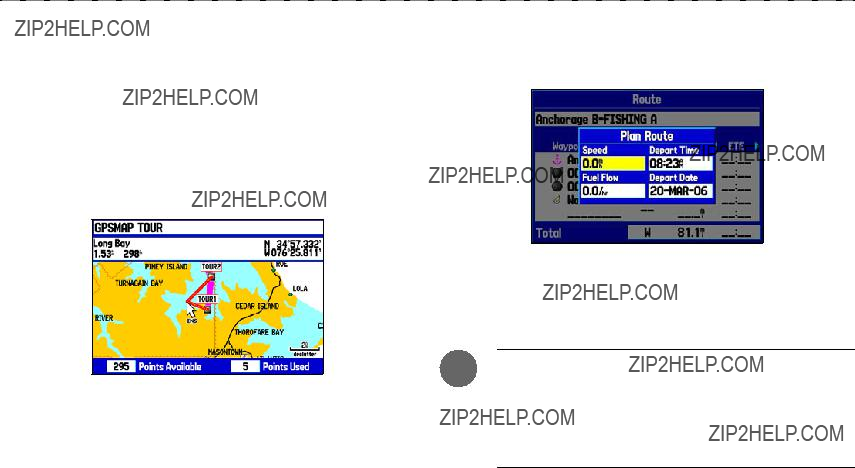
Marine Mode > Creating and Using Routes
To edit the route on the map:
1.Highlight the Route tab on the Main Menu.
2.Select a route, and press Enter. Press Menu to open the Route Review Page options menu.
3.Highlight Edit on Map, and press Enter.
4.Select a location on the route (the route turns red when the arrow is over the route), and press Enter.
5.Use the ROCKER to drag the route to the new point location, and press Enter.
Editing the route on the map
6.If the New Waypoint Page opens, edit the waypoint as needed, highlight OK, and press Enter.
7.Repeat steps 4 through 6 until all points are added to the route. Press QUIT when finished.
You can enter information about your trip so the GPSMAP 378/478 can estimate information about your trip.
To plan your route:
1.Open the Route Review Page options menu.
2.Highlight Plan Route, and press Enter.
Entering Speed and Fuel Flow for trip planning
3.Enter the data for Speed and Fuel Flow. You also can enter the date and time of your departure. Press Quit to return to the Route Review Page.
NOTE: Fuel flow rates are measured in ???units per hour.??? System setting changes for units of measure (statute, nautical or metric) do not affect the fuel flow measure. You should enter fuel flow rates based on information for your vehicle/vessel (such as the operator???s manual or performance specifications), and make note of the units of measure (gallons or liters).

Marine Mode > Creating and Using Waypoints
Manually Transitioning to the Next Waypoint
From the Route tab option menu, highlight Set Up Routes, and press Enter to set the route leg transition (or waypoint transition). Select Distance to enter a radius so that when you are within the entered distance, the GPSMAP 378/478 leads you to the next point on your route.
When you select Manual, you can transition to the next waypoint anytime while navigating a route. While you are navigating
the route, open the Active Route Page, and press Menu. Highlight Next Route Waypoint, and press Enter to have the GPSMAP 378/478 start routing you to the next point in your route.
Creating and Using Waypoints
Waypoints are locations or landmarks you record and store in your GPS. They are locations you might want to return to later, such as checkpoints on a route or significant ground features. You can add waypoints to routes and even create a Go To directly to the selected waypoint.
The GPSMAP 378/478 stores up to 3,000 alphanumeric waypoints with a
???
???
???Text
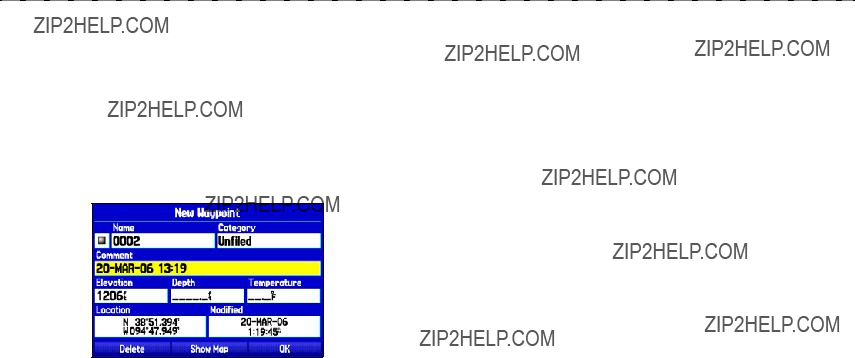
Marine Mode > Creating and Using Waypoints
Marking Your Present Location
Use the Enter/Mark key to capture your present location to create a new waypoint. You must have a valid position (2D or 3D) fix to mark your present location.
To mark your present location:
1.Press and hold the Enter/Mark key until the New Waypoint Page opens, then release it. A default
New Waypoint Page
2.To accept the waypoint with the default information, highlight OK, and press Enter.
To change any information on the New Waypoint Page, highlight the appropriate field, and press Enter. After entering and confirming your changes, highlight OK, and press Enter.
Creating Waypoints Using the Map
You can quickly create a waypoint using the Map Page. When you pan the map and move the arrow over a map item, you see a highlighted description of that item. The GPSMAP 378/478 uses the map item text shown on the map as the default name and symbol for the new waypoint.
To create a new waypoint using the Map Page:
1.Use the ROCKER to move the arrow to the map location or map feature you want.
2.Press and quickly release Enter/Mark to capture the location of the arrow. Pressing and holding Enter/Mark marks your current location, not the arrow???s location.
If you have highlighted a map feature, an information page opens after you press Enter. Highlight Save, and press Enter to save the item as a waypoint. The New Map Waypoint Page opens.
3.To accept the waypoint with the default information, highlight OK, and press ENTER.
To change any information on the New Map Waypoint Page, highlight the appropriate field, and press ENTER. After entering your changes, highlight OK, and press ENTER.
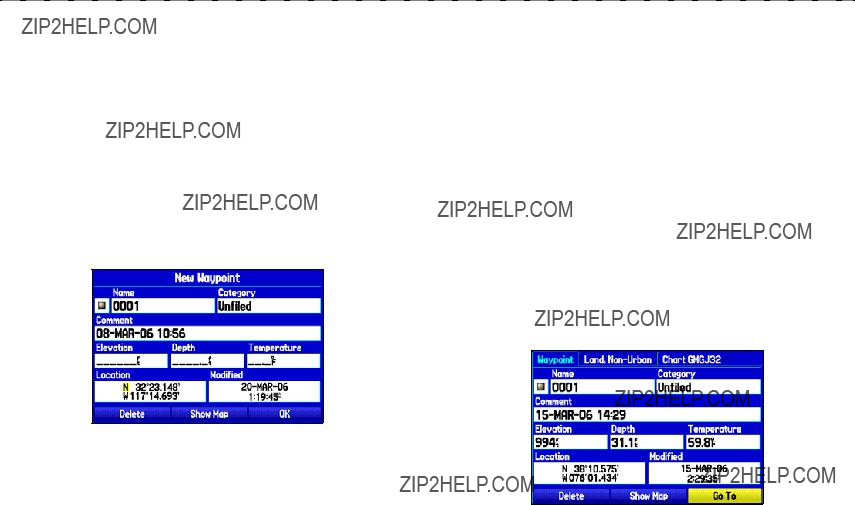
Marine Mode > Creating and Using Waypoints
Creating a Waypoint by Entering Coordinates
You can manually enter location coordinates to create a waypoint.
This method is useful for creating a waypoint at a specific latitude/ longitude position from a chart.
To create a new waypoint by entering location coordinates:
1.Press Enter/Mark to create a waypoint. The new waypoint is created with the next available waypoint number and the receiver???s last know location as the default location.
2.On the New Map Waypoint Page, highlight the Location field, and press Enter.
3.Use the ROCKER to enter location coordinates, and press
ENTER when finished.
To change any of the other information on the New Map
Waypoint Page, highlight the appropriate field, and press
Enter. After entering your changes, highlight OK, and press
Enter.
Reviewing a Waypoint
After you create and store a waypoint, you can modify, review, rename, move, or delete it at any time using the Waypoint Review and Waypoint Edit Pages.
To access the Waypoint Review Page:
Highlight a waypoint on the Map Page, and then press ENTER to open the Waypoint Review Page. If the waypoint is located on a map feature or MapSource or BlueChart g2 feature, the Waypoint Review Page might include additional tabs containing information about other features at that location
Waypoint Review Page
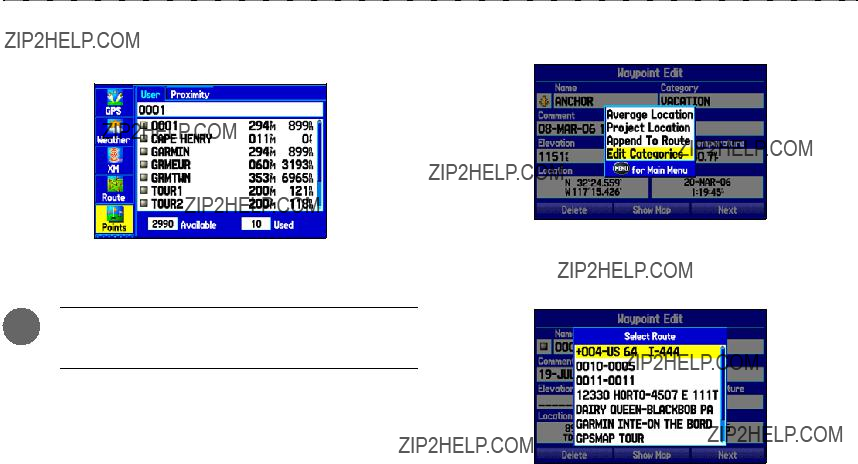
Marine Mode > Creating and Using Waypoints
To access the Waypoint Edit Page:
1.Highlight the Points tab on the Main Menu, and then select a waypoint from the list.
To add a waypoint to the end of the route:
1. Open the Waypoint Edit Page, and press Menu.
Points Tab
2. Press Enter to open the Waypoint Edit Page.
Note: If the waypoint is located on a map feature or MapSource or BlueChart g2 feature, the Waypoint Edit Page will not show the details of the other map features.
Adding a Waypoint to a Route
Use the Append to Route option to add the selected waypoint to the end of a route. This option is available only when you are not navigating. When you are navigating to a destination, Add to
Current Route opens. The selected waypoint is added to the current route before the route destination.
Waypoint Options Menu
2.Select Append To Route, and press ENTER. The Select Route window opens.
3.Highlight a route or select New Route, and press Enter.
4.Highlight OK, and press Enter to save the waypoint.
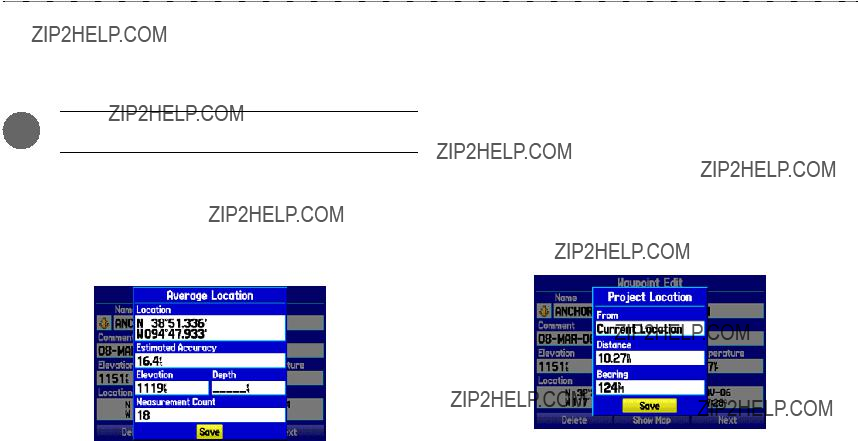
Marine Mode > Creating and Using Waypoints
Averaging the Waypoint???s Location
Average Location makes the unit take several sample location measurements for the waypoint and recalculate for a more accurate location reading.
Note: You must have a GPS satellite fix before you can average a waypoint???s location.
To calculate the average location:
1.Open the Waypoint Page, and press Menu.
2.Select Average Location, and press Enter. The Average
Location window opens. The fields change as the unit calculates the average location of the waypoint.
Projecting a Waypoint
You can create a new waypoint by projecting the distance and bearing from a specific location to a new location.
To create a new waypoint by projecting its location:
1.Create a waypoint. The new waypoint uses the next available waypoint number and the receiver???s last known location as the default location.
2.Use the ROCKER to highlight Points from the vertical list of tabs and select a waypoint. Press ENTER.
3.Press Menu to open the New Waypoint Page options menu.
4.Highlight Project Location, and press Enter.

Marine Mode > Creating and Using Waypoints
6.Select the point that you will project your new waypoint from, just as you would select a waypoint or point of interest. For more information see the ???Finding an Item??? section on page 17.
7.To adjust the distance that the new waypoint will be projected beyond the original waypoint, highlight the Distance field, and press Enter. Enter the projection distance, and press
Enter.
To adjust the bearing that the new waypoint will be projected from the original waypoint, highlight the Bearing field, and press Enter. Enter the bearing, and press Enter.
8.When you have adjusted all elements of the projected location, highlight Save, and press Enter.
9.Make any other changes to the new waypoint data (such as the name or symbol); highlight OK, and press Enter.
Editing a Waypoint
The User sub tab shows a master list of all waypoints stored in memory. From the User list, you can review, edit, rename, or delete individual waypoints or delete all user waypoints.
The number of stored and available waypoints is shown at the bottom of the User sub tab. Stored waypoints are arranged in alphanumeric order.
User Points Tab
To navigate (Go To) a waypoint from the Points tab:
1.Select the Points tab on the Main Menu, and then highlight the User sub tab.
2.Highlight the waypoint you want in the list.
3.Press Nav to open the Navigate Menu. Highlight Go To <Point Name>, and press Enter.
To edit the waypoint:
1.Open the Waypoint Review Page or Waypoint Edit Page.
2.Highlight the waypoint name, symbol, or field you want to change, and press Enter.
3.Use the ROCKER to select a symbol or enter data, and press ENTER when finished.

Marine Mode > Creating and Using Waypoints
Waypoint Page
To edit the next waypoint in the list:
1.Highlight Next, and press Enter. The Waypoint list appears with the next waypoint highlighted.
2.Press Enter to edit that waypoint.
Organizing Waypoints into Categories
You can organize your waypoints into categories, to help manage your waypoints. For example, you can create a Vacation category that stores all of the waypoints you will use for your vacation.
When the vacation is over, you can delete all the waypoints in that category. You can create up to 15 categories.
To create a waypoint category:
1.From any of the waypoint pages or the Points tab, press Menu to open the options menu.
2.Select Edit Categories, and press Enter.
3.Highlight Add, and press Enter.
Entering a new category
4.Use the ROCKER to enter a name for the category.
5.Highlight Save, and press Enter.
To assign a category to a waypoint:
1.Open the Waypoint Edit Page. (You can also change the category on the New Waypoint Page.)
2.Select the Category field, and press Enter.
3.Select the category to which you want to assign the waypoint, and press Enter.

Marine Mode > Creating and Using Waypoints
Select the category to which you want to assign this waypoint.
Waypoint Page
To delete a category:
1.With the Waypoint Categories window open, highlight the category you want to delete, and press Menu.
Waypoint Categories Options Menu
2.Select Delete Category, and press Enter.
3.Press Enter again to finish deleting the category.
Deleting Waypoints
You can delete waypoints from the waypoint list on the Points tab or from the Waypoint Page. To delete a waypoint from the Waypoint Page, use the ROCKER to highlight the
Note: When a waypoint is deleted from the list, it cannot be recovered from the unit. Backup important waypoints to a computer using the optional PC cable and interface software, such as MapSource, or write them down by hand.
To delete a waypoint from the User Points tab:
1.From the Points tab, highlight the waypoint you want to delete.
2.Press Menu, highlight Delete Waypoint, and press Enter.
A confirmation message appears.
3. Press Enter to confirm.
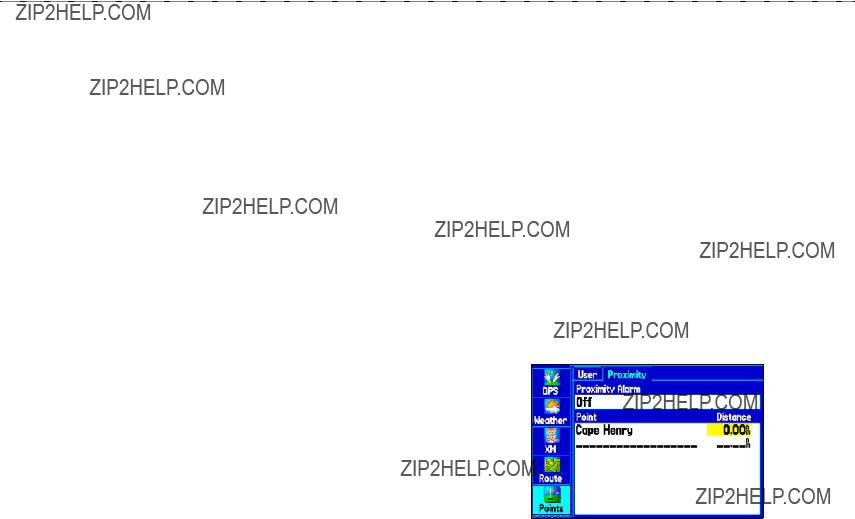
Marine Mode > Creating and Using Waypoints
To delete waypoints by symbol or category:
1.On the User sub tab, highlight the waypoint to delete, and press Menu.
2.Highlight Delete by Symbol or Delete by Category, and press Enter.
3.When deleting by symbol, highlight the symbol of the waypoint you want to delete, and press Enter. When deleting by category, select the category you want to delete from the list, and press Enter.
4.Highlight OK, and press Enter to confirm. Choose Cancel or press Quit to exit without deleting the waypoint.
To delete waypoints by distance:
1.On the User sub tab, highlight the waypoint to be deleted, and press Menu.
2.Highlight Delete By Distance, and press Enter.
3.Select Less Than or More Than and enter the distance using the ROCKER.
4.You can select a waypoint or point of interest as the From location. Highlight the From field and press Enter. From the Find Menu, select a location and press Enter. When OK is highlighted, press Enter.
5.Highlight Delete and press Enter to delete all waypoints within the set location. Choose Cancel or press Quit to exit without deleting the waypoints.
Proximity Points
Use the Proximity Points tab to define an alarm circle around a stored waypoint location. The alarm circle can help you avoid reefs, rocks, or restricted waters. Up to 100 waypoints can be listed with a maximum alarm radius of 99.99 nautical miles, statute miles, or kilometers.
If a proximity alarm circle overlaps an existing alarm circle, a ???Proximity Overlaps Another Proximity Waypoint??? message appears. Because the unit only alerts for one of the overlap points, use caution when navigating in these areas. If you enter an alarm circle overlap, you are only alerted to the closest proximity waypoint.
To turn proximity alarms on or off:
1.Highlight the Points tab on the Main Menu, and then select the Proximity sub tab.

Marine Mode > Creating and Using Waypoints
2.Highlight the field below Proximity Alarm, and press
Enter.
3.Select the On or Off setting, and press Enter.
To add a proximity waypoint:
1.From the Proximity Points tab, use the ROCKER to highlight an empty line on the Proximity list, and press Enter. The Find Menu opens.
2.Select a waypoint or point of interest from the Find Menu.
3.With OK highlighted, press Enter to select the point.
4.Use the ROCKER to enter a distance value (up to 99.99 units), and press Enter.
To clear one or all proximity waypoints from the list:
1.Highlight the Points tab on the Main Menu, and then select the Proximity sub tab.
2.Highlight the proximity waypoint to clear, and press Menu.
Proximity Points Tab Options Menu
3.To clear a single alarm, highlight Remove Point, and press Enter. To clear all proximity waypoints, select Remove All, and press Enter.
4.Highlight OK, and press Enter to confirm.

Marine Mode > Managing Your Tracks
Managing Your Tracks
The GPSMAP 378/478 draws an electronic breadcrumb trail or track log on the Map Page as you travel. The track log contains points along its path, including time, and location for each point.
The track log starts recording as soon as the GPSMAP 378/478 gets a location fix. For the best results, clear the track log before you start traveling because when the track log is full, new track points overwrite the oldest track points.
The percentage of memory used by the current track log appears at the top of the Active tab. After the track log is cleared, it shows zero percent. When the track log reaches 100%, the most recent track points start to overwrite the oldest track points (if Wrap is selected for Record Mode). To avoid losing track points, save the track log when it approaches the 99% mark.
Setting Up and Saving Your Tracks
You must save the track log before you can use the Navigate Track feature. The Save feature allows you to store up to 15 track logs from certain times and dates.
To access the Track tab:
1.Press MENU twice to open the Main Menu.
2.Highlight the Track tab.
Active Track Tab
Record
Resolution records track points based on the resolution. The higher the resolution entered, the more points the unit creates to make the track.

Marine Mode > Managing Your Tracks
To clear the track log:
1.Highlight the Track tab on the Main Menu, then highlight the Active sub tab.
2.Highlight the Clear button, and press Enter. A confirmation message appears.
To save a portion of the track log:
1.Highlight the Track tab on the Main Menu, and then highlight the Active sub tab.
2.Select Save, and press Enter.
3.Highlight No, and press Enter when a message appears.
4.Select a beginning point, and press Enter.
Clearing the Track Log
3. Highlight OK, and press Enter.
To save the entire track log:
1.Highlight the Track tab on the Main Menu, and then highlight the Active sub tab.
2.Select Save, and press Enter. A message appears asking if you want to save the entire track.
3.Highlight Yes, and press Enter.
Saving a Portion of the Track Log
5.Select an ending point, and press Enter.
6.Highlight OK, and press Enter to save the track.

Marine Mode > Managing Your Tracks
Saved Tracks
The Saved sub tab lists all of the saved tracks in your unit. Press MENU to open the Saved tab options menu.
Saved Tab
???Review on
???
???Delete
???Delete
To edit a track:
1.Highlight the Track tab on the Main Menu, and then select the Saved sub tab.
2.Select a track to edit, and press Enter.
3.Highlight the Name field, and press Enter. Use the ROCKER to change the name, and press Enter.
4.Select a different display color to show the track on the map.
5.Highlight the box next to Show on Map, and press Enter.
6.To begin a TracBack, highlight TracBack, and press Enter.
7.To view the track on the map, highlight Map, and press Enter. Press Quit to return to the Track tab.
8.Highlight OK, and press Enter to save your changes.
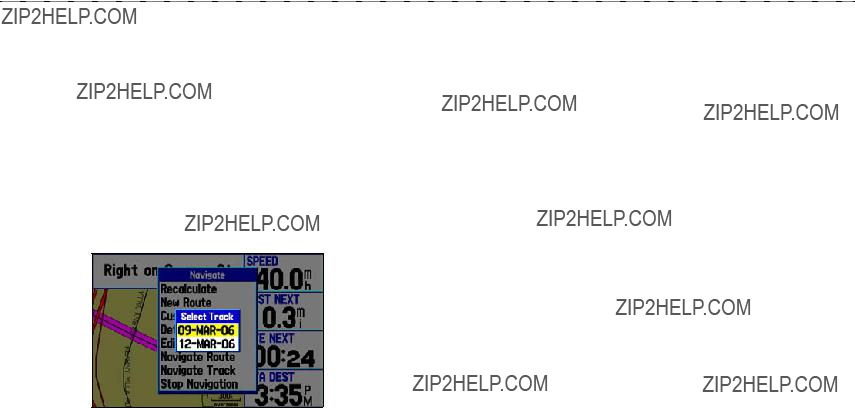
Marine Mode > Managing Your Tracks
Navigating a Saved Track
You can save your track log to use later as a TracBack, which reduces your track log into a route with up to 300 turns. When initiated, a TracBack route leads you back to the oldest stored track log point. It is a good idea to clear the existing track log before you start your current trip. Also, you must save an active track log before you can navigate it as a TracBack.
To start a TracBack using the Nav key:
1.Press Nav, highlight Navigate Track, and press Enter.
2.Highlight the track you want to navigate, and press Enter.
Selecting a Saved Track
3.Select the point you want to navigate to (TracBack to), and press Enter.
TracBack Tips
When a TracBack is initiated, the GPSMAP 378/478 divides the track into segments called legs. Up to 300 temporary turns are created to mark the most significant features of the track in order to duplicate your exact path as closely as possible. To get the most out of the TracBack feature, remember these tips:
???Always clear the track log at the point that which you want to go back (such as a dock or campsite).
???The Record Mode option on the Active Track tab must be set to Fill or Wrap.
???If the track log Interval option on the Active tab is set to the Time option, the route might not navigate your exact path (keep the interval set to Resolution for best performance).
???If the receiver is turned off or satellite coverage is lost during your trip, TracBack draws a straight line between any point where coverage was lost and where it resumed.
???If the changes in distance and direction of your track are too complex, 300 waypoints might not mark your path accurately.
The receiver then uses the most significant points of your track so there will be fewer changes in direction.

Marine Mode Pages > Map Page
Marine Mode Pages
Five pages are available in Marine
Map Page
When you turn on the GPSMAP 378/478, the Map Pages appears after the unit acquires a satellite signal. The position marker ( ) shows your current location on the map.
) shows your current location on the map.
The Map Page shows map information (digital cartography) that includes navaids, lakes, rivers, coastlines, cities, and highways. Use the dedicated zoom keys (In and Out) to adjust the Map Page scale.
Two map operating modes, Position Mode and Pan Mode, determine what cartography is shown on the map display. Position Mode
pans the map to keep your present location in the display area. The position marker ( ) shows your travel on the Map Page. The GPSMAP 378/478 always turns on in Position Mode, with the last
) shows your travel on the Map Page. The GPSMAP 378/478 always turns on in Position Mode, with the last
known location centered on the map. When you press the ROCKER, the GPSMAP 378/478 enters Pan Mode, which moves the map to keep the white arrow  (map pointer) within the display area.
(map pointer) within the display area.
The system has
In Marine Mode, by default, five
Data fields
Current location

Marine Mode Pages > Map Page
Changing the Page???????????? Layout?????????????????? and????????? Data Fields
You can adjust how the following pages appear: Map, Compass, Highway, Position Data, Trip Computer, and optional Sonar Pages.
You can also adjust the data fields on each page.
To change the map page layout:
1.Press Menu to open the options menu.
2.Highlight Set Up Page Layout, and press Enter.
To change a data field display:
1.Press Menu to open the options menu.
2.Highlight Change Data Fields, and press Enter.
3.Highlight the data field to change, and press Enter.
4.Highlight the type of data you want to show, and press
Enter.

Marine Mode Pages > Map Page
Setting Up the Map Page
Use the Set Up Map option to adjust how items appear on the Map Page.
To change a map setup option:
1.On the Map Page, press Menu to open the options menu.
2.Highlight Set Up Map, and press Enter.
Setting up the Map Page
3.Press left or right on the ROCKER to highlight a tab; press up or down on the ROCKER to highlight the field you want to change, and press Enter.
4.Highlight a setting, and press Enter.
5.Press page or Quit to exit.
Viewing Additional Map Data
Use the Map Information Page to view the data currently loaded on your GPSMAP 378/478 unit and data card.
To review/change map information:
1.On the Map Page, press Menu.
2.Highlight Map Information, and press Enter. The first page shows the map families stored on the data card and unit and whether they are shown on the Map Page.
Map Family
highlighted.
Press Enter to view the individual maps in the family.
3.To change the setting for a map family, highlight the box next to the map family name, and press Enter to select (check mark) or deselect (no check mark) the Show setting.
NOTE: The outline of a check mark will appear if one or more maps have been deselected within that map family.
4.To view the list of maps within a map family, highlight the name of the map family, and press Enter.
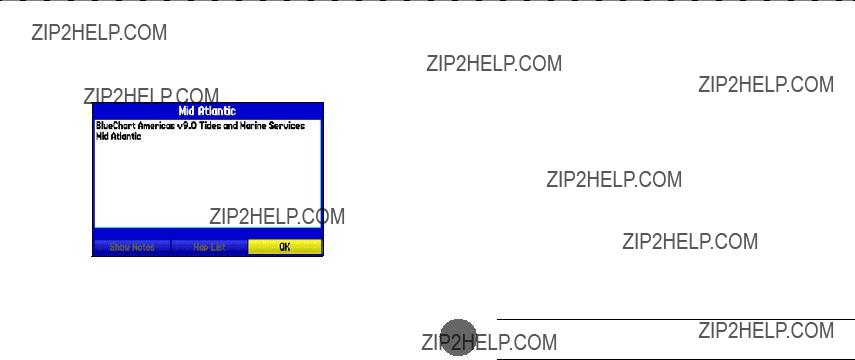
Marine Mode Pages > Map Page
5.When using a map loaded to a data card, you can view detailed information about an individual map, highlight the Map Name, and press Enter. Highlight OK, and press Enter to exit the Map Information Page.
6.To select/deselect individual maps (data card maps only) to be shown on the Map Page, highlight the box next to the map you want, and press Enter to check/uncheck the Show box.
OR
Press Menu, select one of the options (Show All, Hide All, or Show Defaults), and press Enter.
7.Press Quit to exit the Map Information Page.
Map Orientation
There are three map orientation options: North Up orients the map like a paper map. Track Up orients the map in the direction of travel. Course Up orients the map so the direction of navigation is always up. When using Track Up or Course Up, the north arrow indicates the orientation. To change the map orientation, press Menu to open the Map Page. Press Menu again. Select Set Up Map, and press
Enter.
Zooming In and Out of the Map
The map has 28 available map zoom ranges ranging from 20 ft to 800 nm (20 ft to 800 mi or 5 m to 1200 km). The map zoom range is controlled by the In and Out keys, with the current range shown at the bottom right of the data window.
Note: The range value represents the distance from one end of the range bar ( ) to the other.
) to the other.
To select a map zoom range (zoom in and out):
Press the Out key to zoom out; press the In key to zoom in.
Both the GPSMAP 378 and GPSMAP 478 have a

Marine Mode Pages > Map Page
Map coverage conforms to the following conditions:
???Cartography is shown when the selected zoom range is covered by either the internal basemap or other MapSource data loaded onto a data card.
???When the selected zoom range is covered by both the internal database and data card map information, the cartography with the best resolution appears.
???When the selected zoom range exceeds the resolution of the data in use, ???overzoom??? appears below the map scale.
Panning the Map
Use the panning arrow to pan the map to view other map areas. As you pan past the edge of the current map display, the screen moves to provide continuous map coverage. The position icon  stays in your present location and might not be visible on the screen when you pan the map.
stays in your present location and might not be visible on the screen when you pan the map.
To pan the map:
Press up, down, right, or left on the ROCKER. The panning arrow moves the map so you can view different parts of the map.
No additional data is available
???When external data (such as MapSource data) is used, ???detail map??? appears below the map zoom range.
Map feature highlighted 
Using external detailed maps
As you move the arrow, the distance and bearing from your present location to the arrow appears in the data window, along with the arrow???s position coordinates. When you zoom in Pan Mode, the arrow stays centered on the screen. When the arrow is stationary, fixed coordinates appear in the position field, and the distance and bearing from your present location update as you move.

Marine Mode Pages > Map Page
To
Press Quit. The map automatically moves to show your present location, and the unit returns to Position Mode.
You can also use the arrow to select
To view details about an
1.Use the ROCKER to move the arrow to a waypoint or map item. If several items are grouped closely together, zoom in closer for a better view.
When a waypoint or map item is selected, it is highlighted on- screen with the name and location shown at the top of the screen, along with the distance and bearing from your current location.
2.Press Enter to view more information about the point. The information and
3.Use the ROCKER to highlight the extra tabs and view the information.
4.Select an
Map Feature Information Page
Clearing Unwanted Details from the Map
You can remove items from the Map Page (declutter the screen) to remove unwanted items:
To declutter the Map Page:
1.On the Map Page, press Menu to open the options menu.
2.Highlight Declutter, and press Enter.
3.Press Enter again to restore the detail to the map.
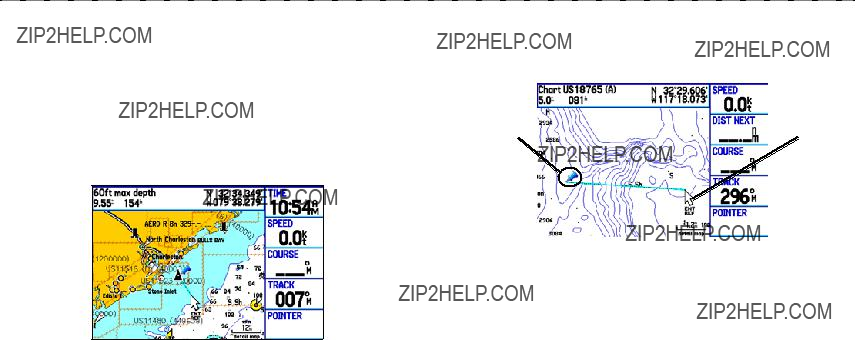
Marine Mode Pages > Map Page
Measuring Distance
You can measure the distance and bearing between two map items.
To measure the bearing/distance between two points:
1.On the Map Page, press Menu to open the options menu.
2.Highlight Measure Distance, and press Enter. An on- screen arrow appears on the map at your present location with ENT REF below it.
3.Move the arrow to the reference point (the starting point that you want to measure from), and press Enter. A push pin icon marks the starting point.
4.Move the arrow to the point want to measure to. The bearing and distance from the reference point and arrow coordinates appear in the data window at the top of the display.

Marine Mode Pages > Compass Page
Compass Page
During active navigation, the Compass Page guides you to your destination with a graphic compass and a bearing pointer. When the pointer is pointing straight up, you are heading directly to your destination.
Compass Page in Marine Mode
If the arrow points up, you are going directly to the waypoint. If the arrow points any direction other than up, turn toward the arrow until it points up, and then continue in that direction.
Note: You must be moving for the compass to accurately update and show your heading.
Turning On the Compass Page
The Compass Page is on by default in Marine Mode but off by default in Automotive Mode.
To show the Compass Page in Automotive Mode:
1.Highlight the Display tab on the Main Menu.
2.Highlight the Compass Page field, and press Enter.
3.Select On, and press Enter.
The middle of the page features a rotating compass ring that shows your course over ground (track) while you are moving. Your present course over ground is indicated at the top of the compass ring. The direction of the destination (bearing) relative to the course over ground is indicated by an arrow in the middle of the compass ring, and a course to steer indicator on the outside of the compass ring. The course to steer represents the direction to steer to get back to the course line.
Turning on the Compass Page

Marine Mode Pages > Compass Page
Compass Page Options
Use the options menu on the Compass Page to customize the
Compass Page. For definitions of data field options, see to page 132.
Press Menu to open the Compass Page options menu.
Set Up Page
Show Course Pointer/Show
Show (Hide) Bug
Change Data
Using the Marine Timer
The Marine Timer, specifically designed for sail boat racing, allows you to easily count up or down by specified time increments. As
is common in sail boat racing, there is often a
You can use your GPSMAP 378/478 to perform each of these different countdowns.
To open the Marine Timer:
1.Press Menu on the Compass Page.
2.Highlight Set Up Page Layout, and press Enter.
3.Highlight 2 Columns With Timer, and press enter. The Marine Timer appears in the

Marine Mode Pages > Compass Page
To use the Marine Timer:
1.Press the ROCKER up or down to select the time you want to count. Five (5) minutes is the default.
2.Press Enter to start the timer. Use the ROCKER during the timing to quickly select a different length of time.
3.Press Enter to stop timing.
Marine Timer on the Compass Page
As discussed previously, the timer is set to count down five minutes.
If you want to change the length of time and the behavior of the timer, open the Timers Setup tab on the Main Menu.
note: You can set the timer countdown for up to 60 minutes.
To set the Marine Timer:
1.Highlight the Setup tab on Main Menu, and then select the Timers sub tab.
2.Highlight Stop next to Marine to change the timer???s behavior.
3.Highlight the time field, press enter, and then use the
ROCKER to enter a new time.

Marine Mode Pages > Highway Page
Highway Page
The Highway Page is available in both Marine Mode and Automotive Mode.
Highway Page
When you are navigating, the Highway Page provides digital and graphic steering guidance to the destination. The right side of the
Highway Page features
The red vertical bar represents the bearing to your course. To stay on course, steer toward the red vertical indicator (or arrows) until it lines up with the violet bar in the middle. The bottom of the screen provides visual guidance to the waypoint on a graphic highway display. The line down the center of the highway represents your desired track line.
To hide/show the Highway Page:
1.Highlight the Display tab on the Main Menu.
2.Highlight the Highway Page field, and press Enter.
3.Select Off to hide or On to show, and press Enter.
Using the Highway Page
To stay on course, steer toward the violet bar (or arrows) until it lines up with the red bar in the middle. The bottom section of the screen provides visual guidance to the waypoint on a graphic
highway display. The line down the center of the highway represents your desired track line.
As you head toward your destination, the highway perspective moves to indicate your progress to the waypoint and which direction you should steer to stay on course. If you are navigating a route, the Highway Page shows each route waypoint in sequence connected by a black ???road??? with a white line down the middle, which is your desired track line. Nearby waypoints not in the active route can also be shown. You can zoom in or out to show a larger or smaller view of the highway.
To change the highway perspective scale:
Press In to zoom in; press Out to zoom out.

Marine Mode Pages > Highway Page
Highway Page Options
Use the Highway Page options menu to define the data fields and select which waypoints and tracks appear on the screen. The data fields, located along the right side of the page, provide various types of useful data.
To show and select the Highway Page options:
1.Press page repeatedly until the Highway Page appears.
2.Press Menu.
3.Highlight an option, and press Enter.
The following options are available from the Highway Page options menu:
Set Up Page
Change Data
Set Up
Set Up Highway
Highway Page Options Menu

Marine Mode Pages > Active Route Page
Active Route Page
When you are navigating a route using your GPSMAP 378/478, the Active Route Page shows each point (waypoint or map item) of the active route, with the point name, course, distance, and several other fields of information. The current destination point, the active point, is marked with an arrow icon. As you navigate a route, the list automatically updates to indicate the next active point. The Active Route and Route Review Pages share many of the same features and options.
Active Route Page
Active Route Page Options
Press Menu to open the Active Route Page options menu.
Add
Remove
Plan
Change Data
Active Route Page.

Marine Mode Pages > Position Data Page
Position Data Page
The Position Data Page shows important navigation data while navigating a route in Marine Mode. By default, the Position Data Page shows a compass ribbon, your current latitude and longitude, date and time, your location in relation to a prominent nearby landmark such as a waypoint or city, and eight
Position Data Page Options
Press MENU to open the Position Data Page options menu.
Your present location is 4.9 nm west of Waypoint 0001.
Position Data Page
Change Nearest
Reset
Reset Max
Reset
Reset

Marine Mode Pages > XM Audio Page
XM Audio Page
Use the XM Audio Page to view and select XM Radio channels. Add or remove channels within the Favorites category, and turn audio on or off.
Note: You MUST have a GXM 30 antenna connected to your GPSMAP 378/478 and a subscription to XM Radio to use XM Radio features. Additionally, you must use the external speaker with
Category
name
Channels
The XM Audio page is available in both Marine Mode and Automotive Mode. The XM tab appears on the Main Menu, even if the XM Audio Page is turned off.
The XM Audio Page is divided into three panes. The first pane contains a list of XM Radio categories into which XM Radio channels are grouped (Classical, Decades, Traffic, and so on). For a complete list of available categories and channels, visit the XM Radio web site at www.xmradio.com. Select All Channels to view a list of all channels in numerical order. You can also view a list of your favorite channels.
The second pane shows a list of channels in the selected category. Each channel has a description and the artist currently playing. You can adjust this setting to show the song title instead of the artist.
The third pane shows the song and artist or program name, the channel number and name, and the strength of the XM Radio signal.

Marine Mode Pages > XM Audio Page
Turning on the XM Audio Page
The XM Audio Page is off by default.
To show the XM Audio Page:
1.Highlight the Display tab on the Main Menu.
2.Highlight the XM Audio Page field, and press ENTER.
3.Select On, and press ENTER.
XM Audio Page Field on the Display Tab
To select an XM Radio channel:
1.Press up or down on the ROCKER to scroll through the list of channels.
2.Highlight the channel you want, and then press ENTER.
A triangle ( ) appears to the left of the channel currently playing.
) appears to the left of the channel currently playing.
XM Audio Page Options
With the XM Audio Page open, press MENU to open the options menu.
XM Audio Page Options Menu
The following options are available on the XM Audio Page options menu:
Add to
Display Artist (Display Song) In
Mute (Enable) Audio

Marine Mode Pages > XM Audio Page
Using Favorites
You can create a customized list of up to 30 of your favorite XM Radio channels.
To add a channel to Favorites:
1.Highlight the Category list, and press ENTER.
2.Select a category, and press ENTER, or use the IN and OUT keys.
3.Select a channel.
4.Press MENU.
5.Highlight Add To Favorites, and press ENTER. Repeat steps 1 through 4 to add another channel.
Adding a Channel to Favorites
To view and select Favorites:
1.Highlight the Category list, and press ENTER.
2.Select the Favorites category, and press ENTER.
3.Highlight the channel you want to select from your list of favorites, and press ENTER. A triangle appears to the left of the newly selected channel.
Selected
channel
Favorites List
To delete a channel from Favorites:
1.In the Favorites category, highlight the channel you want to delete, and press MENU.
2.Highlight Delete Favorite to delete the selected channel from your favorites list, or highlight Delete All Favorites to delete all channels from your Favorites list.
3.Press ENTER. A confirmation message appears.
4.Highlight OK, and press ENTER again to confirm.

Marine Mode Pages > XM Audio Page
Scanning XM Radio Channels
From the XM Audio Page, you can scan all channels, scan channels in a specific category, or scan channels in your Favorites.
To scan XM Radio channels:
1.On the XM Audio Page, press MENU.
2.Select Scan on the options menu, and press ENTER.
3.Select All Channels to scan all channels.
OR
Select Category to scan only channels in the selected category.
OR
Select Favorites to scan only channels in your Favorites list.
4.Press ENTER. Each channel is played for five seconds and then advances to the next channel.
5.Press any key to stop scanning and select the current channel.
Turning Audio On or Off
To turn audio on or off:
1.On the Audio sub tab, press MENU.
2.Highlight Mute Audio Output on the options menu to turn the audio off. A music note with a red slash appears in the song pane. Highlight Enable Audio Output to resume audio output.
Audio output is muted
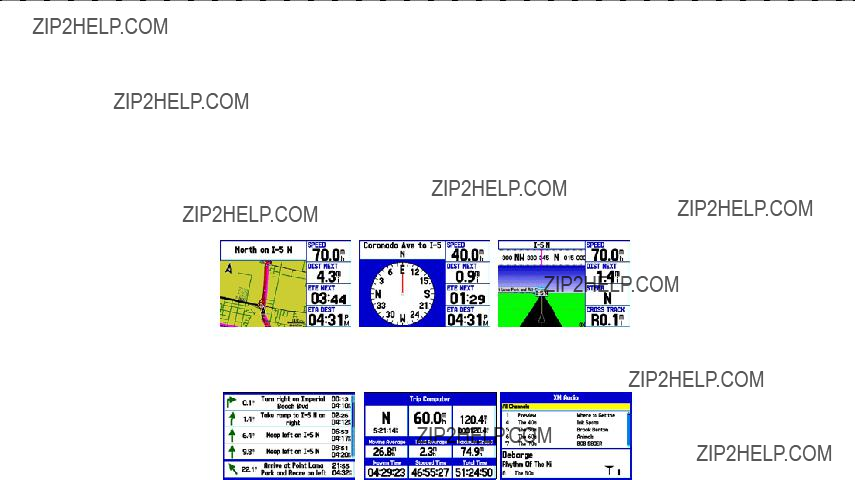
Automotive Mode > Automotive Mode Pages
Automotive Mode
This section discusses some of the more common Automotive operations you will perform with your GPSMAP 378/478 in Automotive Mode. Please note that many common operations, such as marking a waypoint and creating a route, are performed the same way as in Marine Mode. See the Marine Mode sections for operations and information not found in this section.
Automotive Mode Pages
Automotive Mode has two main pages (Map and Trip Computer) that are always available. Optional Highway, Compass, and XM Audio Pages can be turned on in Automotive Mode. When you are actively navigating, the Current Route Page is available if you are navigating a
Current Route Page Trip Computer Page Optional XM Audio
Page (see page 52)

Automotive Mode > Navigating in Automotive Mode
Navigating in Automotive Mode
You can navigate to your destination in Automotive Mode using the Map Page. As you travel, your GPSMAP 378/478 guides you to your destination with voice prompts, arrows, and directions along the top of the screen. When you are actively navigating, you see
a magenta line that always runs from your current location to the destination or to the next turn on the Map Page. You can use the Map Page, Compass Page or Highway Page to help navigate.
You can navigate to a destination using one of the following methods:
???Select a point on the map, and press the Nav key.
???Press the Nav key to navigate a new route using the Find Menu, or start a saved route or track.
???Press the Find key to search for a particular item and create a route to it.
Navigate Options Menu
Press NAV to open the Navigate Menu.
Navigate Menu
Go To
New
Custom
Edit
Navigate
Navigate Track
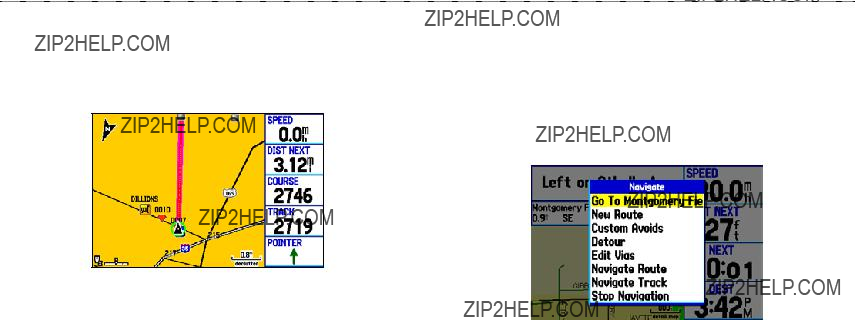
Automotive Mode > Navigating in Automotive Mode
To navigate (Go To) a point on the map:
1.Highlight a point to navigate to, and press NAV.
2.Highlight Go To <point name>, and press ENTER.
3.Follow the magenta line created on the Map Page.
Stopping and Resuming Navigation
When navigating to a point, you can stop navigation. For example, if you are on a long car trip, but you want to stop for dinner, you can stop navigation and resume after dinner.
To stop navigation:
1. While navigating to a point, press NAV.
Navigate Menu
2.Highlight Stop Navigation, and press ENTER.
3.Highlight Resume Navigation, and press ENTER.

Automotive Mode > Navigating in Automotive Mode
To create a new route:
1.Press Nav to open the Navigate Menu.
2.Highlight New Route, and press Enter.
3.From the Find Menu, highlight Waypoints, and press Enter. (You can also choose to go to other points, such as Cities or Exits from this list. The steps vary only slightly from those listed for waypoints.)
4.Select a waypoint from the list, and press Enter to open the Waypoint Review Page.
Waypoint Review Page
Activating a Go To using the Find Menu
5.Highlight the Go To button, and press Enter to begin navigation.
To go to a destination using the Find Menu:
1.Press Find to open the Find Menu.
2.Highlight a category, and press Enter.
3.Press Enter, and use the ROCKER to begin entering the letters contained in the item name. The list begins to sort by the items which contain the letters you are entering. Press
Enter when finished.
4.Highlight the item you want from the list, and press Enter.
5.Highlight the Go To button, and press Enter.
For complete information about finding an item, see the ???Finding an Item??? section on page 17.
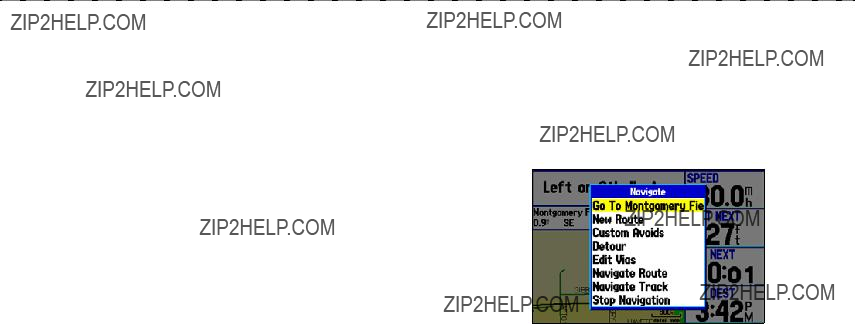
Automotive Mode > Editing Your Route
Following a Saved Route
Use the Navigate Menu to follow a saved track or route. If you want to follow roads on your route, press Menu and select Follow Roads on the Active Route Page.
To follow a saved route:
1.Press Nav to open the Navigate Menu.
2.Highlight Navigate Route, and press Enter.
3.Highlight the route you want to navigate, and press Enter.
4.Press Menu to open the options menu.
5.Highlight Follow Roads, and press Enter to create a
You can also initiate a saved route from the Route tab on the Main Menu.
Editing Your Route
When you are navigating a route, you can edit that route. You can add areas and roads to avoid as well as temporary detours to your current route. You can also add stops along your trip, called Via Points.
While navigating, press Nav to open the Navigate Menu.
Navigate Menu in Automotive Mode
While navigating a course
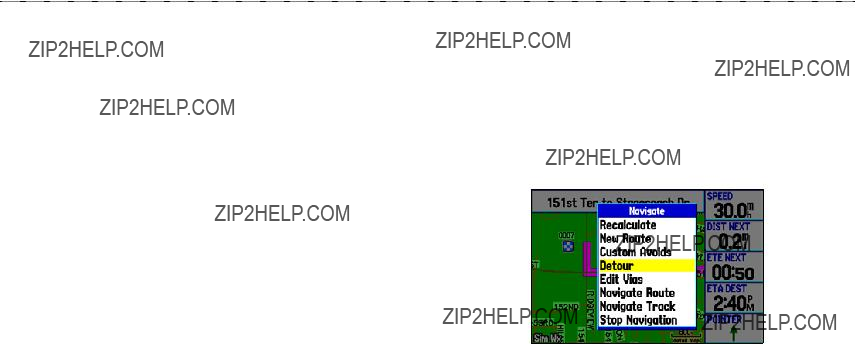
Automotive Mode > Editing Your Route
Entering Custom Avoids
The Custom Avoids feature allows you to enter specific areas and roads to avoid when navigating. Custom Avoids apply to all routes, but detours apply to only the active route. You can add Custom Avoids while you are navigating a route or before you navigate.
To enter a custom avoid:
1.Press Nav while navigating to a destination.
OR
Open the Map Page, and press Menu.
2.Select Custom Avoids, and press Enter.
3.Press Enter when the Add Avoid button is highlighted.
4.Select Avoid Road or Avoid Area, and press Enter.
5.Use the ROCKER to move the arrow to the first point in the avoidance area. Press Enter to select the first point.
6.Move the arrow to the end point, and press Enter. During route calculation and navigation, the GPSMAP 378/478 will avoid the area within the box or the selected area of the road.
7.When finished, highlight the OK button, and press Enter.
Creating a Detour
If there is road construction or some other form of a detour while navigating a route, you can have your GPSMAP 378/478 create a detour route for you.
To create a detour:
1.While navigating a course, press Nav.
2.Select Detour from the Navigate Menu.
3.Select a distance, and press Enter. The GPSMAP 378/478 recalculates your course based on your detour distance.
4.To end the detour manually, press Nav again, and select
Cancel Detour.

Automotive Mode > Editing Your Route
Adding and Editing Stops (Via Points)
You can add Via
To add Via Points to your route:
1.While navigating your route, press Nav to open the Navigate Menu.
2.Select Edit Vias, and press Enter. The Add/Edit Vias window opens.
3.Highlight Add Via Point, and press enter.
5.If you selected Use Map, use the ROCKER to select an item on the map, and press Enter.
If you selected Use Find Menu, select an item from the Find Menu as discussed in the ???Finding an Item??? beginning on page 17. Remember you can press Menu while the Find
Menu is open to find an item near another location, such as the destination. The new point is added to the route as shown on the Add/Edit Vias Page.
6.Repeat steps 3 through 5 until you have added all of the Via Points that you want. Highlight Done, and press Enter to apply the new Via Points to the route.
Add/Edit Vias Page
Showing the original route without Via Points
4.From the

Automotive Mode > Following an Automotive Route
Following an Automotive Route
The GPSMAP 378/478 guides you to your destination using many tools, such as the Map Page and Current Route Page.
Track Your Progress with the Map Page
You can track the progress of your route on the Map Page. Your route is shown with a magenta line. The next turn is shown in the top bar on the Map Page.
Map Page Displaying Your Route
Watch Your Trip Data
Use the Trip Computer Page to view your trip data. You can track your speed here, as well as other information related to your trip.
See Your Next Turn With the Current Route Page
Whenever you have initiated a
Current Route Page

Automotive Mode Pages > Map Page
Automotive Mode Pages
Automotive Mode has two main pages, Map and Trip Computer, that are always available. Optional Highway and Compass Pages can be turned on in Automotive Mode. When you are actively navigating, the Current Route Page is available if you are navigating a
Data fields
Current
location  Map zoom
Map zoom
navigating off road. For information about pages not discussed here, see the ???Marine Mode Pages??? section.
Map Page
range
Map Page
In Automotive Mode, by default, four
GPS status or the route leg. You can also add data fields to the page or select a
Press the zoom keys (In and Out) to change the map zoom range. Some items on the map appear only if the map is zoomed in to a certain level.
???Press Enter to quickly declutter (remove unwanted items) from the Map Page.
???Press Menu to open the options menu for the Map Page.
???Show and hide the heading line from the options menu.
???Use the ROCKER to measure the distance between two objects on the map.
???Change the page layout and data fields to customize the Map
Page.
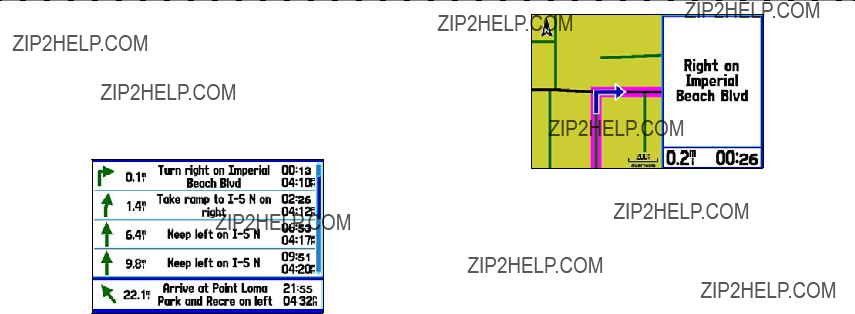
Automotive Mode Pages > Current Route Page
Current Route Page
Whenever you start a route in the GPSMAP 378/478 in Automotive Mode, the Active Route Page shows each turn of the active route, with the distance to the turn, the street name, and estimated time to arrival and time of arrival. As you navigate a route, the turn list automatically updates to indicate the next turn at the top of the list.
Current Route Page
You can scroll through the entire list by moving the scroll bar up or down. Highlight any of the turns on the list, and press Enter to view the Next Turn Page for that turn. The Current Route and Next Turn Pages show similar information using a different layout. The Next Turn Page shows your next turn on a map.
Next Turn Page
Saving the Current Route
You can save the current route from the Current Route Page. Press Menu to save the route. Press Enter when Save Route is highlighted. Your route is automatically saved, using the starting point and destination as the route name. Press Enter when OK is highlighted to finish saving the route.

Automotive Mode Pages > Trip Computer Page
Trip Computer Page
The Trip Computer Page shows important data while navigating a route in Automotive Mode. It indicates your current speed and other data about your trip, such as average speed and moving time.
Trip Computer Page Options Menu
Press Menu to open the options menu. Highlight an option, and press Enter.
Trip Computer Page
Reset the Trip Computer before beginning a trip. If you make frequent stops, leave the GPSMAP 378/478 turned on in order to receive satellites. This allows the unit to accurately measure elapsed time during the trip.
Trip Computer Page Options Menu
Set Up Page
Change Nearest
Position Data (2 Columns) layout]. The choices change based on the current Usage Mode.
Reset (Trip, Max Speed, Odometer,

Main Menu > Main Menu Tabs
Main Menu
The Main Menu provides access to various waypoint, system, navigation and interface management, and setup menus.
Main Menu
To select a tab from the Main Menu:
1.From any page, press MENU twice to open the Main Menu.
2.Highlight the tab you want. The information for the highlighted tab automatically appears on the right. To highlight a sub tab, press left or right on the ROCKER, and then press up or down to select individual fields.
Main Menu Tabs
???
???
???
???
???
???
???
???
???
???
???
???
???
???
???
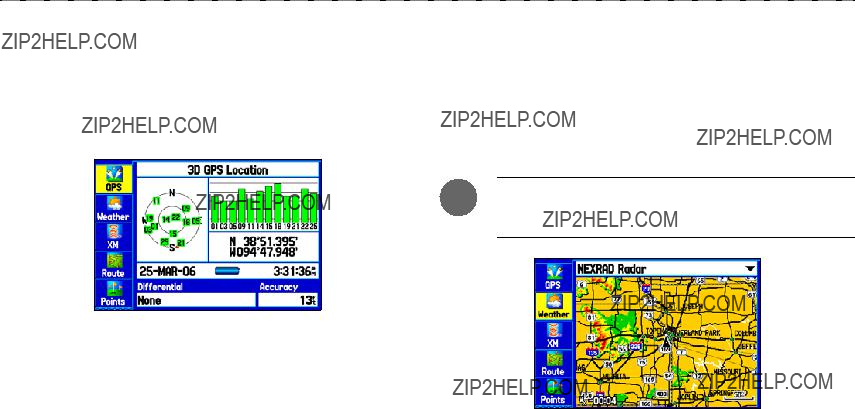
Main Menu > GPS Tab and Weather Tab
GPS Tab
The GPS tab provides a visual reference of satellite acquisition, receiver status, and accuracy. The sky view and signal strength bars give an indication of what satellites are visible to the receiver and whether they are being tracked. For more information about GPS, see pages
Weather Tab
Use the Weather tab on the Main Menu to view individual weather features without turning all other weather features on or off. For example, you can select Storm Cells to view only storm cells on the Map window that appears on the Weather tab. When you close the Main Menu and return to the Map Page, all of your previously selected weather features still appear on the Map Page.
Note: You must have a subscription to XM WX Weather, and the GXM 30 antenna must be plugged into the USB port on the back of the unit to use features described in this section.
Main
Main
For more information about XM Weather, see the ???Using XM WX
Weather??? section beginning on page 95.

Main Menu > XM Tab
XM Tab
The XM tab is where you can view and select XM Radio channels, add or delete favorites, and obtain radio ID and XM WX Weather service level information. The XM tab is divided into two sub tabs:
Audio and Information.
Note: The XM tab always appears on the Main Menu, regardless of whether the XM Audio Page is turned on or off. For more information about the XM Audio Page, see page 52.
name
Audio Sub Tab
The Audio sub tab shows XM Radio channel categories, a list of available channels, information about the selected channel, and the strength of the XM signal.
Information Sub Tab
Use the Information sub tab to view the radio identification number,
XM WX Weather subscription information, and a list of weather features available to you based on your subscription plan. The Information sub tab also shows the age of each weather report in minutes.
Radio ID
For more information about XM Weather, see the ???Using XM WX Weather??? section beginning on page 94.

Main Menu > Route Tab and Points Tab
Route Tab
The Route tab shows all the routes currently stored in memory, along with a descriptive name for each route.
Use the Route tab create and store up to 50 reversible routes, with up to 300 points each. See the ???Creating and Using Routes??? section beginning on page 20 for more information about routes.
Main
Points Tab
The Points tab contains two sub tabs, User and Proximity, which allow you to manage a large number of waypoints quickly and efficiently. For more information about waypoints, see the ???Creating and Using Waypoints??? section beginning on page 24.
Main
User Sub Tab
The User sub tab shows a master list of all waypoints currently stored in memory. The total number of stored and available waypoints appear at the bottom of the User sub tab.
Proximity Sub Tab
Use the Proximity sub tab to define an alarm circle around a stored waypoint location.

Main Menu > Track Tab and DSC Tab
Track Tab
Use the Track tab to specify whether or not to record a track log, define how it is recorded, or save the track log data for future use.
The Track tab is divided into two sub tabs: Active and Saved. For more information about tracks, see the ???Managing Your Tracks??? section beginning on page 34.
Main
Active Sub Tab
The Active sub tab is for the active log (the log currently being recorded). It shows the amount of track memory used and current settings.
Saved Sub Tab
The Saved sub tab shows a list of all saved tracks in your GPSMAP 378/478.
DSC Tab
Use the DSC tab (Marine Mode only) to control and set up the Digital Selective Calling (DSC) features. DSC uses marine VHF radio and GPS to transmit and receive location information. DSC is used by mariners for distress calls and position reporting.
For more information about DSC and Maritime Mobile Service Identity (MMSI) numbers, see pages
DSC Page

Main Menu > DSC Tab
Understanding Distress Calls
With your GPSMAP 378/478 properly connected to a VHF radio with DSC output, you can receive any DSC distress call within range. An alert message appears and a tone sounds when a distress call is received. The alarm only sounds on a distress call; position reports do not sound the alarm. Distress calls are broadcast to
all DSC users in radio range and appear with a blue and white checkered icon on the DSC Call List and Log tabs.
You can enter a caller???s name, if it is known. The caller???s name replaces the MMSI number as a reference once entered.
Understanding Position Reports
The Position Report operates similarly to the distress call. This type of contact is like a phone call; no emergency alarms are set off. Position reports are not broadcast to all DSC users and appear with a gold boat icon.
Receiving DSC Calls
Each time you receive a distress call or position report, a review page
Page. Both pages contain identical fields to the DSC Entry Review
Page.
Each entry in the Call List and Log has a corresponding DSC Entry Review Page. This page operates similarly to the Distress Page and Position Report Page. From the DSC Entry Review, you can Delete the entry, Save it as a waypoint, or show the location on the map.
To review a call or log entry:
1.Open the Call List or Log from the DSC tab.
2.Highlight the call you want to review.
3.Press Enter to open the DSC Entry Review Page.
DSC Entry Review Page

Main Menu > DSC Tab
DSC Call List
The Call List sub tab shows the 50 most recent calls, even if the unit is left unattended. The Call List only shows the most recent call from a vessel. If a second call is received, it replaces the first call in the Call
List. Press Menu to sort the list and delete entries.
DSC Call List
DSC Log
When DSC calls are received, they are automatically stored in the Log, with the latest call at the top. The unit can store up to 100 calls; after 100 calls are received, the oldest log file is removed when a new call is received.
DSC Log
Receiving a Position Report or Distress Call
After you receive a Position Report or a Distress Call, you can quickly navigate to the location. Highlight a call from the Call List or Log and press Direct To. The top selection in the Navigate Menu is highlighted. Press Enter to go to the location.
DSC Directory
The DSC Directory is like a phone book and can hold up to 50 entries.

Main Menu > DSC Tab
DSC Directory
entries. Press
Enter to open the Entry Review Page.
Highlight OK, and press ENTER to save the Directory entry.
To add a new Directory entry:
1.Open the DSC Directory on the Main Menu.
2.Highlight the first blank space in the directory list, and press
Enter.
OR
Press Menu, highlight New Item, and press Enter.
3.Enter the MMSI number, the name, and any comments.
4.When finished, highlight OK, and press Enter.
After creating a New Directory Item, the name created is attached to that particular MMSI number. If you return to the Log, the new name appears under the corresponding MMSI number.
Another way to input a name is from the Entry Review Page or the DSC Distress Call Page or DSC Position Report Pages. The Name and MMSI are sent to other Garmin GPS units: Only the MMSI numbers are sent to other
Making a Distress Call
To make a distress call, press the MayDay button on your VHF radio. The call transmits on an emergency channel with the MMSI number attached to the call, if you have DSC support. Any DSC- equipped mariner (on sea or land) within range can receive the call.
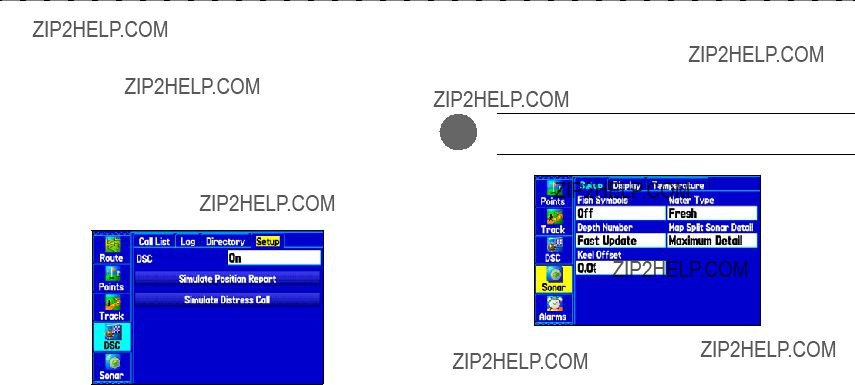
Main Menu > Sonar Tab
Setting Up DSC
Use the Setup sub tab to turn DSC on and off. If you have more than one chartplotter and only want DSC to show on another chartplotter, turn DSC off on this unit.
This Setup sub tab also allows you to simulate distress calls and position reports while the unit is in Simulator Mode (see page 12). Simulating calls is helpful for practice before connecting to the real system. The Distress Call simulator also helps to check if alarms are working properly.
Sonar Tab
Use the Sonar tab contains options for the Sonar Page. See the ???Setting Up and Using Sonar??? section beginning on page 103 for more information about sonar setup options.
NOTE: You must have a GSD 21 Sounder Module connected to your GPSMAP 378/478 to use sonar.
Main
DSC Setup

Main Menu > Alarms Tab
Alarms Tab
Use the Alarms tab to define alarm settings. When an alarm goes off, the alarm message appears on the GPSMAP 378/478 and the unit emits five (5) beeps.
Main
To set an alarm:
1.Highlight the Alarms tab on the Main Menu.
2.Select an alarm to set, and press Enter.
3.Change the setting to On, and press Enter. If necessary, highlight the next field to the right, and press Enter. Enter the settings you want.
4.Press ENTER to finish.
When you set an alarm to be persistent, the alarm message appears on the screen and the unit beeps until you press Enter to acknowledge the alarm.
To set a persistent alarm:
1.Highlight the Alarms tab on the Main Menu.
2.Highlight the box next to the alarm you want to make persistent.
3.Press Enter to place a check mark in the Persist box.
Navigation (Nav) Alarms
The Nav sub tab contains the following alarms:
Next
Off
Anchor

Main Menu > Alarms Tab
System Alarms
GPSMAP 378/478 must be on for the clock alarm to work.
Ext. (External)
Weather Alarms
Tornado
Thunderstorm
Flood
Flash Flood
Marine

Main Menu > Calendar Tab
Sonar Alarms
Shallow Water/Deep
Water
Calendar Tab
Use the Calendar tab to plan trips, view sun and moon, and hunting and fishing information for the day.
Highlight an arrow and press ENTER to change the date in the view.
Calendar Tab in Day View
Calendar Options
The options menu is available in all three calendar views. Press Menu on any of the calendar views to open the options menu.
To view the Sun & Moon Information tab or Hunt & Fish sub tab, highlight View Sun and Moon or View Hunt and Fish, and press Enter.

Main Menu > Celestial Tab
To add a route (or point) to the calendar:
1.Highlight the Calendar tab on the Main Menu. The current day appears on the Day View sub tab.
2.Press Menu to open the options menu. Highlight Add Route (or Add Point), and press Enter.
3.From the
Day View Sub Tab
The Day View sub tab shows sunrise and sunset times for your current date and location. Points and routes for the day appear in a list.
Week View Sub Tab
The Week View sub tab provides the same elements as Day View, but the entire week is visible. Days with added points or routes are shown highlighted in green. Icons for the points and routes assigned to the date are shown along the bottom of the screen.
Month View Sub Tab
The Month View sub tab provides the same elements as Day View, but the entire month is visible. Days with added points or routes are shown highlighted in green. Icons for the points and routes assigned to the date are shown along the bottom of the screen.
Celestial Tab
The Celestial tab shows tide information, sun and moon information, and hunting and fishing information. You can view data for your current location, a location from the map, or a waypoint location. Also, you can select a different date and time, or use the current data.
Main
To access the Celestial tab:
1.Highlight the Celestial tab on the Main Menu.
2.Use the ROCKER to select the sub tab you want, such as
Sun & Moon.

Main Menu > Celestial Tab
Tide Sub Tab
The Tide sub tab contains a graphical chart that shows tide station information in a
The top of the page shows the tide station and date being referenced. The chart shows a
The tide curve appears as a shaded area; higher tides are taller and lower tides are shorter. The bottom of the page indicates the times with the highest and lowest tides.
To view a tide chart for a different tide station:
1.From the Tide sub tab, highlight the At field, and press Enter. The Find Menu opens showing the tide stations.
2.Press Menu, and select Near Current Location, Near Current Route, Near Other (select another location using the map), or Near Destination. The list is updated with your search requirements.
3.Select a tide station from the list, and press Enter. The Tide Station Information Page appears.
4.Highlight OK, and press Enter. The Tide tab appears again showing the tide chart for the selected tide station.
To view the tide chart for another date:
1.From the Tide sub tab with a chart open, highlight the On field, and press Enter.
2.Enter the date with the ROCKER, and press Enter. You can also use the zoom In and Out keys to view information for another date. Press and hold In or Out to scroll quickly through dates.
3.Press Enter when finished. The unit shows the chart for the date you entered or selected.
To use the current date again, highlight the Date field. Press Menu, highlight Use Current Date, and press Enter.
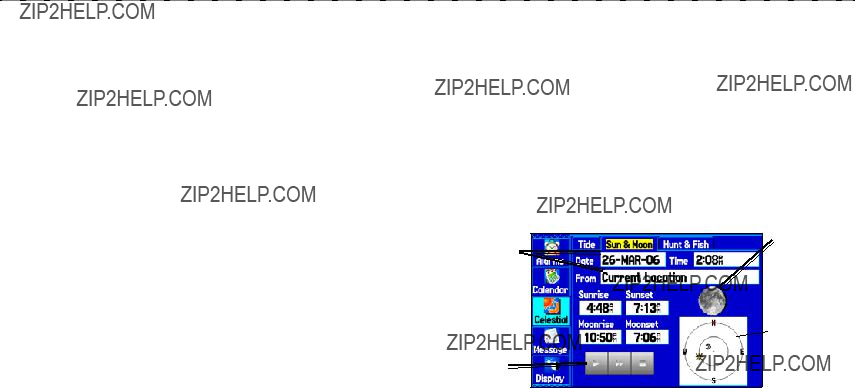
Main Menu > Celestial Tab
To view a chart???s details for another time during the day (other than current time):
1.From the Tide sub tab with the chart you want to view, press Menu, and then select Move Cursor.
2.Press the ROCKER right or left to view the chart at another time.
3.To return to the current time, press Menu, and select Stop Moving Cursor.
To automatically start Pointer Mode to scroll the chart:
To view sun and moon information for a different date:
1.Highlight the Date field, and press Enter.
2.Use the ROCKER to change the digits of the date to the date you want. You can also use the zoom In and Out keys to view information for another date. Press and hold In or Out to scroll quickly through dates.
3.Press Enter when finished. The unit shows the sun and moon information for the date you entered or selected.
4.To use the current date again, highlight the Date field. Press
MENU, highlight Use Current Date, and press ENTER.
Sun & Moon Sub Tab
The Sun & Moon sub tab provides you with sunrise/sunset and moon rise/set times. A graphic of the moon phase also appears.
You can view Sun & Moon information for any date or location.
You can also use the play, fast forward, and stop buttons to view an animation of the Sun & Moon sub tab.
Select the date and location
Animation controls for the sky view
Moon phase
 Location of the sun and moon in the sky view
Location of the sun and moon in the sky view
Sun & Moon Sub Tab

Main Menu > Celestial Tab
To view sun and moon information for a different location:
1.Highlight the From field, and press Enter.
2.Highlight Use Find Menu, and press Enter. The Find Menu automatically opens.
3.Select a waypoint or point of interest, and press Enter.
4.On the Waypoint Information Page, press Enter. The unit shows the sun and moon information for the location you selected.
To use the current location, highlight the From field. Press Enter, highlight Current Location, and press Enter again.
Hunt & Fish Sub Tab
The Hunt & Fish sub tab provides you with predictions of the best times to hunt and fish in a selected location on a specific date.
To show the Hunt & Fish information:
1.Highlight the Celestial tab on the Main Menu.
2.Select the Hunt & Fish sub tab.
Hunt & Fish Sub Tab
To view hunt and fish information for a different date:
1.Highlight the Date field, and press Enter.
2.Use the ROCKER to change the digits of the date. You can also use the zoom In and Out keys to view information for another date. Press and hold In or Out to scroll quickly through dates.
3.Press Enter when finished. The unit shows the information for the date you entered.
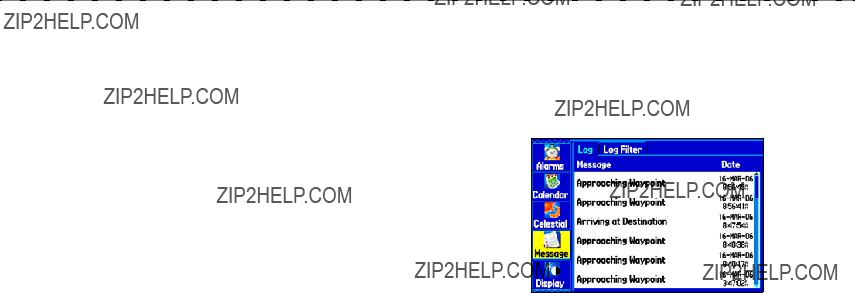
Main Menu > Message Tab
To use the current date again, highlight the Date field. Press Menu, highlight Use Current Date, and press Enter.
To view hunt and fish information for a different location:
1.Highlight the From field, and press Enter.
2.Highlight Use Find Menu, and press Enter. The Find Menu opens.
3.Select a point, and press Enter.
4.On the information page, press Enter. The unit shows Hunt & Fish information for the selected location.
To use the current location:
1.Highlight the From field, and press Enter.
2.Highlight Current Location, and press Enter.
Message Tab
The Message tab shows a list of messages generated by the GPSMAP 378/478. Use the ROCKER to scroll through the entire list of messages on the Log sub tab. Use the Log Filter sub tab to show only the message types that you want to view.
Main
To view messages:
1.Highlight the Message tab on the Main Menu.
2.Highlight a message.
3.Press Enter to view detailed information about the message.

Main Menu > Display Tab
To show or hide messages using the log filter:
1.Highlight the Message tab on the Main Menu.
2.Highlight the Log Filter sub tab. All messages appear by default.
Display Tab
Use the Display tab to set display features, such as pages to show in the main page sequence and how long the backlight stays on.
Message Log Filter Tab
3.Highlight the message type you want to hide, and press Enter. The message name appears in the Hide window.
4.Highlight the message, and press Enter to show it again.
Main
Main
Color
Backlight

Main Menu > Sound Tab
Twilight
Highway
XM Audio
Compass
Backlight
Sound Tab
Use the Sound tab to customize the sounds made by your GPSMAP 378/478.
Main
Audio
Line Out.
Attention
Voice
Voice
Speaker
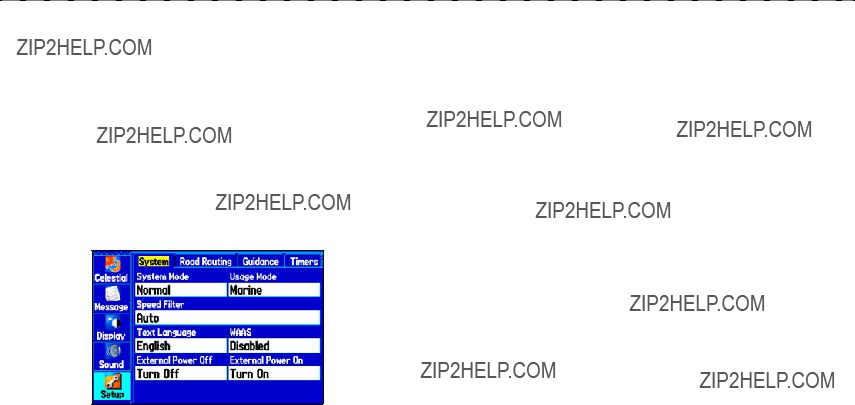
Main Menu > Setup Tab
Setup Tab
To customize how your GPSMAP 378/478 looks, use the System tab to adjust certain system settings.
System Sub Tab
Use the System sub tab to control settings for System Mode, Speed Filter, Text Language, WAAS, and External Power.
To access the System sub tab:
1.Highlight the Setup tab on the Main Menu.
2.Select the System sub tab.
Usage
Automotive Mode.
Speed
Text
External Power
External Power
Main
System

Main Menu > Setup Tab
Road Routing Sub Tab
Use the Road Routing sub tab to select road routing settings.
To access the Road Routing sub tab
1.Highlight the Setup tab on the Main Menu.
2.Select the Road Routing sub tab.
Road Routing Sub Tab
Route
???Faster
???Shorter
???Off
Ask My
Calculation
???Quickest
???Quick
???Better
???Best
Calculate Routes
Custom
Custom Road

Main Menu > Setup Tab
Guidance Sub Tab
Use the Guidance sub tab to set guidance information.
To access the Guidance sub tab
1.Highlight the Setup tab from the Main Menu.
2.Select the Guidance sub tab.
Guidance Sub Tab
Next Turn
Timers Sub Tab
Use the Timers sub tab to set timers and view information about how long the unit has been on.
To access the Timers sub tab
1.Highlight the Setup tab from the Main Menu.
2.Select the Timers sub tab.
Timers Sub Tab
Since
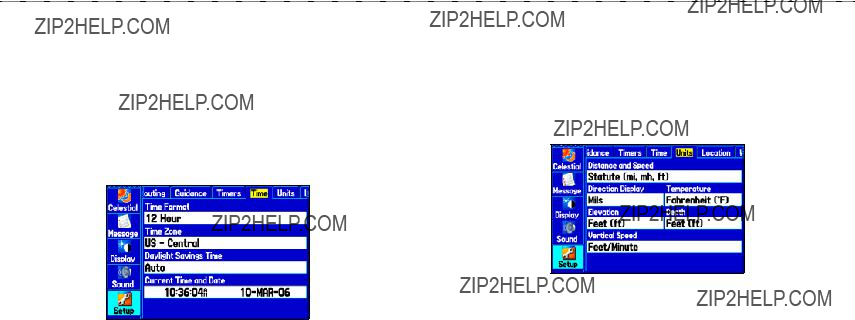
Main Menu > Setup Tab
Time Sub Tab
Use the Time sub tab to set the time format and zone, and set the unit to conform to Daylight Saving Time. The current time and date appear in the Current Time and Date field.
To access the Time sub tab
1.Highlight the Setup tab on the Main Menu.
2.Select the Time sub tab.
Time Sub Tab
Time
GPSMAP 378/478 will show the correct local time. Select Other to enter a UTC Offset.
If the wrong date appears, press Menu, highlight Set Date, and press Enter. You are prompted to enter the current year. The GPSMAP 378/478 uses this information when gathering satellite data to show the correct date.
Units Sub Tab
Use the Units sub tab to customize measurement units.
To access the Units sub tab
1.Highlight the Setup tab on the Main Menu.
2.Select the Units sub tab.
Distance and
Direction
Vertical
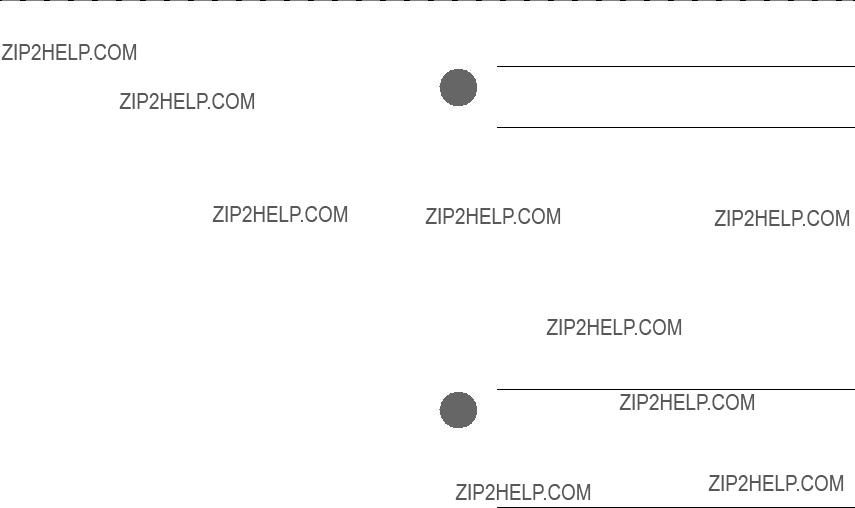
Main Menu > Setup Tab
Location Sub Tab
Use the Location sub tab to change location setting information.
To access the Location sub tab:
1.Highlight the Setup tab on the Main Menu.
2.Select the Location sub tab.
See the ???Appendix??? for more information about location formats and map datums. Also visit the National Imagery and Mapping Agency at www.nima.mil for more information on grids and datums.
Changing the Location Format
When you change the Location Format, you change the coordinate system in which a given location reading appears. The default format is latitude and longitude in degrees, minutes, and thousandths of a minute (hddd??mm.mmm). Only change the location format if you are using a map or chart that specifies a different location format or want to use a format you are familiar with.
Selecting a Different Map Datum
Datums are used to describe geographic positions for surveying, mapping, and navigation and are not actual maps built in the unit.
Only change the datum if you are using a map or chart that specifies a different datum.
The default setting is WGS 84. The unit automatically selects the best datum depending on your chosen location format.
WARNING: Selecting the wrong map datum can result in substantial position errors. When in doubt, use the default WGS 84 datum for best overall performance.
Selecting a Different Heading Reference
You can select from Auto Mag Var, True, Grid, and User Mag Var.
Auto Mag Var provides magnetic north heading references that are automatically determined from your current location. True provides headings based on a true north reference. Grid provides headings based on a grid north reference (and is used in conjunction with the grid position formats). User Mag Var allows you to specify the magnetic variation at your current location and provides magnetic north heading references based on the variation you enter. Enter the magnetic variation of your current location in the Magnetic Variation field if you selected User Mag Var for the heading.
WARNING: If User Mag Var is selected, the unit does not automatically calculate and update the magnetic variation at your present location. You must update the magnetic variation as your location changes. Failure to update this setting can result in substantial differences between the information shown on your unit and external references, such as a magnetic compass.

Main Menu > Setup Tab
Welcome Sub Tab
Use the Welcome sub tab to enter information, such as your name and address, or a welcome message that appears when you turn on your GPSMAP 378/478.
To access the Welcome sub tab:
1.Highlight the Setup tab on the Main Menu.
2.Select the Welcome sub tab.
Welcome Sub Tab
To add a welcome message:
1.Highlight one of the Welcome Message fields, and press
ENTER.
2.Use the ROCKER to enter information in the fields. You do not need to enter information in every field. When finished, press ENTER again.
3.To show the welcome message when you turn on your GPSMAP 378/478, highlight the Show at
Interface Sub Tab
Use the Interface sub tab to change the data format and control the input/output format used when connecting your unit to external devices.
To access the Interface sub tab:
1.Select the Setup tab on the Main Menu.
2.Select the Interface sub tab.
Interface Sub Tab

Main Menu > Setup Tab
Serial Data
???Garmin Data
???GARMIN
???Garmin Remote
???NMEA In/NMEA
???RTCM
???RTCM In/NMEA
???RTCM In/Text
???Text
???
If you select GARMIN DGPS or RTCM In/NMEA Out format, you can control a differential beacon receiver directly from your GPSMAP 378/478 using the Interface sub tab. You can have the unit automatically scan for the DGPS beacon signal, or you can enter the beacon frequency and bit rate on the unit, and the information will be used to tune the beacon receiver. If you use a DGPS receiver, WAAS capability is automatically turned off.
To have the unit automatically scan for a frequency:
1.Set the unit to GARMIN DGPS or RTCM In/NMEA Out.
2.Highlight the Beacon field, and press Enter.
3.Highlight Scan, and press Enter. The numbers in the
Frequency field change as the unit scans from 284 kHz to
325 kHz, 200 bit rate, then 100, at

Main Menu > Setup Tab
Interface Sub Tab with Garmin DGPS Selected
The Status field shows one of the following:
???
???
???
???Check
To restart the scan:
1.Press Menu.
2.Highlight Restart Scan, and press Enter.
To manually enter a frequency and bit rate:
1.With the unit set to Garmin DGPS or RTCM In/NMEA Out, highlight the Beacon field, and press Enter.
2.Highlight User, and press Enter.
3.Highlight the Frequency or Bit Rate field, and press Enter.
4.Enter a frequency or bit rate. Press Enter when finished
When the unit is receiving a DGPS signal, the Signal to Noise Ratio
(SNR) and Distance fields show data. The SNR range is 0 dB to 30 dB, with 30 being the best. The Distance field might or might not show data, depending on the signal being broadcast from the DGPS site.
The DGPS beacon transmitters are operated by the United States Coast Guard (or similar government agency in other countries), which is responsible for their accuracy and maintenance. For DGPS transmitter problems or to find the most updated list of frequencies and coverage areas, contact your local USCG or see their Web site at www.navcen.uscg.mil/.

Main Menu > Setup Tab
Advanced NMEA Output Setup
If you are going to interface the GPSMAP 378/478 with another piece of equipment (such as a radar or autopilot), the unit needs to be set to output NMEA data. The NMEA data transmission can be customized to keep the output rate at two seconds. If too many NMEA sentences are activated, the unit might take longer than two seconds to update.
You can also set the Output Rate to Fast to output a minimum number of NMEA sentences at
To access the Advanced NMEA Output Setup:
1.Highlight the Setup tab on the Main Menu.
2.Select the Interface sub tab.
3.Highlight the Serial Data Format field, and press Enter.
4.Select NMEA In/NMEA Out, and press Enter.
5.Press Menu to open the options menu. Select Advanced NMEA Setup, and press Enter.
Advanced NMEA Output Setup
Use the Advanced NMEA Output Setup Page to set the output rate, change the precision of the Lat/Lon minutes, set Waypoint IDs to names or numbers, and turn on and off the GPS status, the Garmin Proprietary sentences, and Waypoint/Route (WPL, RTE).
GPSMAP 378/478 NMEA Sentence Output (NMEA version 3.01 compliant):
???Always transmitted: GPRMC, GPGGA, GPGLL, GPBWC,
GPVTG, GPXTE, GPRMB
???Switchable sentences: GPGSA, GPGSV, GPWPL, GPRTE
???Garmin proprietary: PGRME, PGRMZ, PGRMM
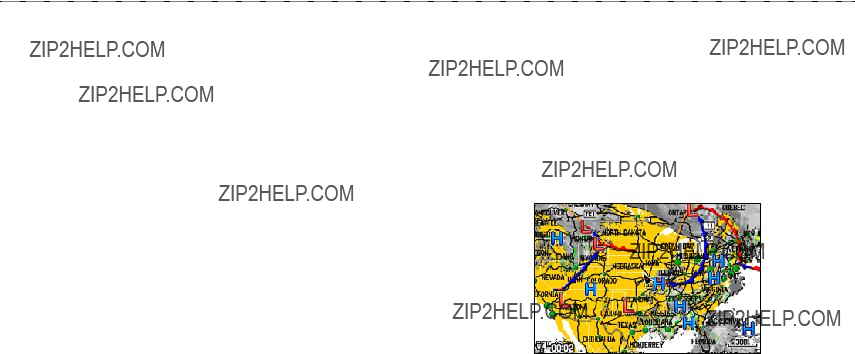
Using XM WX Weather > Viewing XM WX Weather and Setting XM WX Weather Options
Using XM WX Weather
This section describes how to use XM WX Satellite Weather with your GPSMAP 378/478. You must have a subscription to XM WX Weather, and you must plug your GXM 30 antenna into the USB port on the back of the unit to receive the XM signal. If you do not have a subscription to XM WX Weather, the features described in this section work only when the GPSMAP 378/478 is in Simulator Mode and the GXM 30 antenna is unplugged.
You can view XM WX Weather on your GPSMAP 378/478 in one of three ways:
???To view all weather information on the map, use the Map Page.
???To view a specific weather feature such as NEXRAD Radar or
Storm Cells, for example, you can use the Weather tab on the Main Menu. For more information, see page 98.
???To view current weather conditions and forecast information for your current location or a specific location, use the
Weather Data option on the Find Menu. For more information, see page 101.
Viewing XM WX Weather
From the Map Page, you can turn weather information on or off.
To turn XM WX Weather on or off on the Map Page:
Press and hold the MENU/Wx key to toggle XM Weather on or off.
OR
Press MENU, select Hide (Show) Weather, and then press
ENTER.
Map Page with XM WX Weather
Setting XM WX Weather Options
Use the Map Page options menu to adjust the way weather items appear on the Map Page. Three

Using XM WX Weather > Setting XM WX Weather Options
To set up weather options on the Map Page:
1.From the Map Page, press Menu to open the options menu.
2.Highlight Set Up Map, and press Enter.
Map Page Options Menu
3.Highlight the Weather, Srfc Wx, or Mrn Wx tab.
4.Highlight the field you want to change, and press Enter.
5.Press page or Quit to exit.
Weather Tab
Use the Weather tab to turn XM WX Weather data on or off on the Map Page, and set the map zoom range at which weather information first appears on the Map Page.
Weather Tab
Weather
NEXRAD Radar, Satellite Mosaic, Lightning, Storm Cells,

Using XM WX Weather > Setting XM WX Weather Options
Srfc Wx Tab
Use the Srfc Wx tab to set the map scale at which surface weather information first appears on the Map Page.
Mrn Wx Tab
Use the Mrn Wx tab on the Map Page Options to set up marine weather options.
Srfc Wx Tab
Surface Winds, Surface Pressure, Fronts, Visibility, County
Mrn Wx Tab
Water Temperature, Wave Period, Wave Direction, Wave Height, Marine
20 ft to 800 nm.
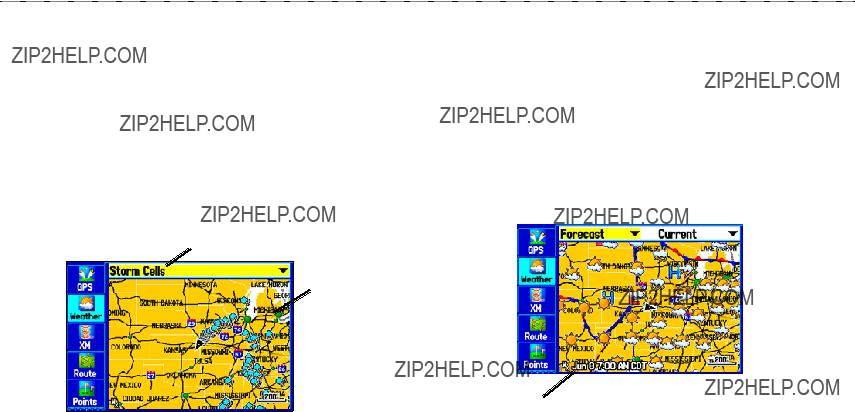
Using XM WX Weather > Using the Weather Tab
Using the Weather Tab
Use the Weather tab on the Main Menu to quickly view individual weather settings without turning all other weather features on or off. For example, you can select Storm Cells to view only storm cells on the Weather tab. When you close the Main Menu and return to the Map Page, all of your previously selected weather features still appear on the Map Page.
Depending on which mode you are in, different options appear. Use the zoom IN and OUT keys to zoom in or out on the map.
Weather information type
Map window
Weather Tab with Storm Cells
To view a specific XM WX Weather Information Type:
1.Highlight the Weather tab on the Main Menu.
2.Select the Weather Information Type field.
3.Select (scroll through) the weather information type you want to view. The map refreshes to show only the selected information type.
From the Weather tab, you can view the current conditions or forecast on the map for the next 12, 24, 36, or 48 hours.
To view the forecast map:
1.In the Weather Information Type field, highlight Forecast. The Map window shows the current forecast in the Map window.
 Map
Map
window
Forecast Map
Age of the weather report
2.Highlight the field to the right of Forecast, and press ENTER to show a list of forecast options.
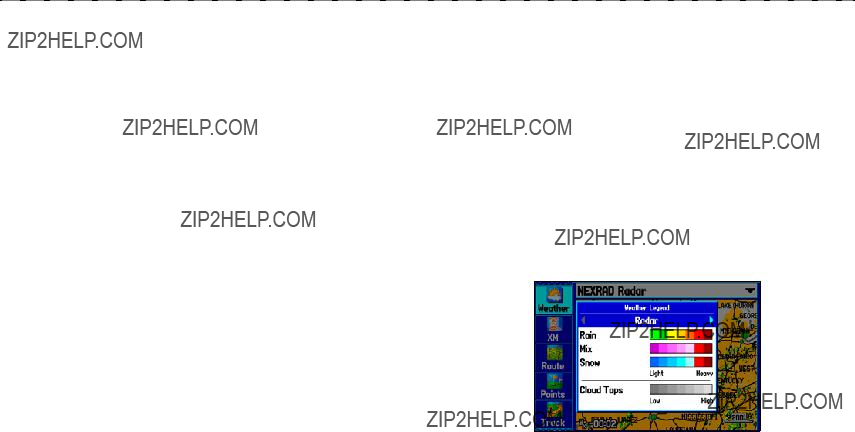
Using XM WX Weather > Using the Weather Tab
3.Highlight the forecast you want to
24 Hour, 36 Hour, or 48 Hour, and press ENTER. The Map window on the Weather tab is updated with forecast information for the time you selected.
The age of the weather report appears in the
To pan the map:
Press and hold the MENU/Wx key, or press MENU, highlight Show Map Pointer, and press ENTER. The panning arrow  appears so you can pan the map to view other map areas.
appears so you can pan the map to view other map areas.
Weather Options
Use the options menu on the Weather tab to select weather options for the Map window on the Weather tab.
To select weather options:
1.Highlight the Weather tab on the Main Menu.
2.Press MENU.
Declutter On
Animate Weather (Stop
Show Map
Weather
Weather Legend
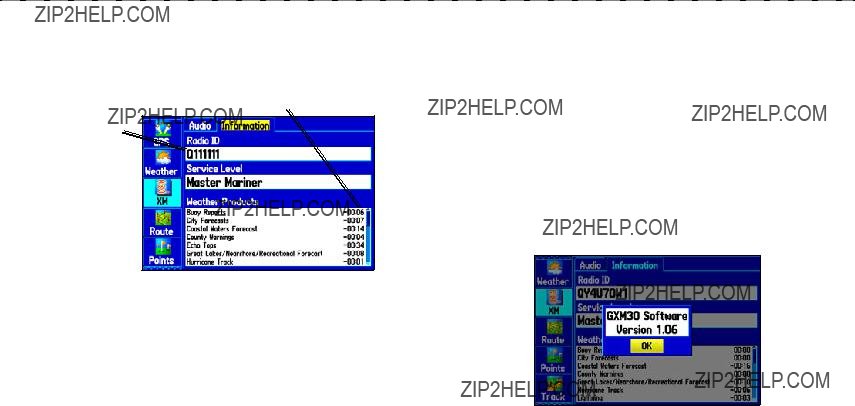
Using XM WX Weather > Using the Weather Tab
Viewing Additional XM Weather Information
Use the Information sub tab to view the radio identification number, service level information, and list of weather products.
Age (in minutes) of weather data
Radio ID
Subscription 
package
List of available weather features
weather features
Information Sub Tab
The Information sub tab contains the following information:
Radio
Service
Weather
Accessing GXM 30 Antenna Information
Use the Information sub tab to obtain version information about your GXM 30 antenna.
To view information about your GXM 30 antenna:
1.Highlight the XM tab on the Main Menu.
2.Select the Information sub tab.
3.Press MENU.
4.With Antenna Information highlighted, press ENTER. A window appears showing the software version loaded to your GXM 30 antenna.
5. Press ENTER to close the window.

Using XM WX Weather > Finding Weather Information
Finding Weather Information
You can use the Find Menu to access weather information for your current location or from another location on the map. By selecting the Weather Data option on the Find Menu, you can view the current conditions, forecast information, sea surface conditions, and weather bulletins. For more information about the Find Menu, see ???Finding an Item??? beginning on page 17.
To find weather information for your current location:
1.From any page, press FIND.
2.Select Weather Data, and press ENTER. The Weather From Current Location Page opens.
Weather From Current Location
3.Highlight the Forecast tab to view the weather forecast for your current location.
Forecast high
 temperature
temperature
Chance of precipitation
Forecast low temperature
Weather Forecast
4.Highlight the Sea Surface tab to view sea surface information.
Sea Surface Information
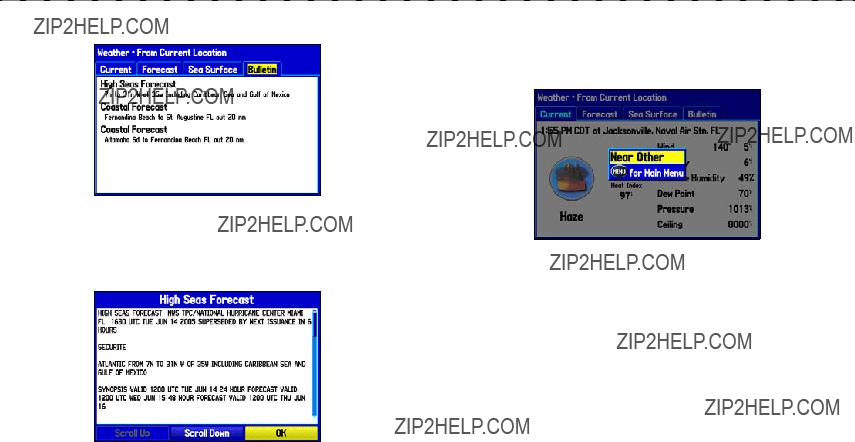
Using XM WX Weather > Finding Weather Information
5. Highlight the Bulletin tab to view marine weather bulletins.
To find weather data for a different location:
1.Press MENU on the Weather From Current Location Page.
2.With Near Other highlighted, press ENTER.
Marine Weather Bulletins
You can highlight a weather bulletin, and press ENTER to view the full text of the marine weather bulletin.
Marine Weather Bulletin
3.Move the map pointer to a different location, and press ENTER. The Weather From (New Location) Page opens with weather information for the selected location.
4.Press MENU, highlight Near Current Location, and then press ENTER to return to the forecast for your current location.

Setting up and Using Sonar > Showing Sonar on the Map Page
Setting Up and Using Sonar
This section covers the additional sonar options for the GPSMAP 378/478 when used in conjunction with a GSD 21 Sounder Module. Read the GSD 21 Sounder Module Installation Instructions to properly install the sounder module. When you turn on your GPSMAP 378/478, the sounder module automatically turns on.
Note: You MUST have a GSD 21 installed and connected to your GPSMAP 378/478 to use the sonar features.
The Sonar Page is added to the end of the page sequence when you are in Marine Mode. To view the Sonar Page, press Page or Quit repeatedly until it appears.
Showing Sonar on the Map Page
You can change the layout of the Map Page to view a split screen to show the sonar on the Map Page. You must be in Marine Mode to use sonar.
To show the Sonar Page on the Map Page:
1.Press and hold Page/MODE.
2.Highlight Marine, and press Enter.
3.Press Page or Quit to open the Map Page.
4.Press Menu. Highlight Set Up Page Layout, and press
Enter.
5.Highlight Map with Sonar, and press Enter.
Map Page with Split Screen
To resize the Map Page sonar split screen:
1.After showing the Sonar and Map Pages together in the split screen as described in the previous steps, press Menu.
2.Highlight Size Split, and press Enter.
3.Use the ROCKER to move the vertical
4.Press Enter.
5.To stop resizing the screen, press Quit. You can also press Menu, highlight Stop Resizing, and press Enter to stop resizing the screen and retain the previous split setting.

Setting up and Using Sonar > Using the Sonar Page
Using the Sonar Page
When combined with a GSD 21 Sounder Module, your GPSMAP
378/478 becomes a powerful fishfinder/flasher with the Sonar Page.
If a GSD 21 is attached, but the unit does not detect a transducer, a ???Sonar Turned Off??? message appears across the Sonar Page. The Sonar Page appears only if a GSD 21 has ever been attached or when the unit is in Simulator Mode.
The middle of the page contains a
The sonar returns show as red (strongest), then orange (strong), yellow (medium), green (weaker), and blue (weakest). The Fish Symbols option allows you to view the actual sonar data, a fish symbol or a combination of both. When the unit is set to Dual, the appearance of the fish symbols changes. Fish symbols from the center of the beam (200 kHz) are solid (or narrow arches), but the returns from the edges of the beam (50 kHz) are hollow (or wide arches).
The sonar display can also be set to show a split screen view of a zoomed portion of the sonar, bottom lock (display scaled from the bottom up), or a combination of these options. For example, you can choose to show dual frequency at a 2X zoom (Dual 2X) on one half and normal range dual frequency (Dual) on the other half. The current display mode appears at the bottom of each sonar display.
Read the ???Understanding Sonar??? section beginning on page 112 for more on information about sonar.
Sonar Page

Setting up and Using Sonar > Using the Sonar Page
Adjusting the Sonar Page
Use the Adjustment Menu to access the settings and features most commonly used on the Sonar Page. Ten main adjustment options are available: Range, Zoom, View, Gain, Target Level, Whiteline, Frequency, Depth Line, Noise Reject, and Scroll. The currently selected option appears in the
To select an adjustment option:
Use one of the following methods to select an adjustment option:
???Press the ROCKER right or left to scroll through the adjustment options. When the adjustment option you want appears, press Enter.
???Press Menu, highlight Adjustments, and press Enter. Use the ROCKER to highlight the adjustment and press
Enter.
After you select an adjustment option, press the ROCKER up or down to change the setting.
You can also press Menu and highlight a shortcut setting to quickly change to commonly used settings and values.
Press Enter to accept the new setting (or press Quit to cancel) and return to the Sonar Page.
Sonar Adjustment Options
???2X

Setting up and Using Sonar > Using the Sonar Page
???2X
???4X
???4X
???Btm (Bottom)
???Btm (Bottom)
Tip: Quickly zoom in and out of the Sonar display by pressing the In and Out keys. Turn off the zoom function by pressing the Out key until the No Zoom setting appears.
Target
Depth
Noise
The Noise Reject can be turned Off, set to Normal (automatically adjusts for optimum viewing), or to a fixed

Setting up and Using Sonar > Using the Sonar Page
Resizing the Split Screen
You can adjust the way the split screen appears. This option is only available when a zoom scale other than No Zoom is selected.
To resize the Sonar Page split screen:
1.From the Sonar Page split screen, press Menu.
2.Highlight Size Split, and press Enter.
3.Move the horizontal
Enter.
4.If you want to cancel this operation, press Quit or press
Menu, highlight Stop Resizing, and press Enter.
Using the Pointer on the Sonar Page
You can show the pointer (arrow)  to reference sonar items and mark underwater waypoints. This makes it easier to find and use an object such as a stump for a future fishing location. When using this feature, the Sonar Page pauses. The depth continues to update while the display is paused, but the unit does not show any new sonar data until the Sonar Page resumes scrolling. You might see a discontinuity from where the sonar information stops and where it starts again.
to reference sonar items and mark underwater waypoints. This makes it easier to find and use an object such as a stump for a future fishing location. When using this feature, the Sonar Page pauses. The depth continues to update while the display is paused, but the unit does not show any new sonar data until the Sonar Page resumes scrolling. You might see a discontinuity from where the sonar information stops and where it starts again.
To mark an underwater waypoint:
1.From the Sonar Page, press Menu, highlight Show Pointer, and press Enter.
2.Use the ROCKER to move the pointer to the location you want to mark. Press Enter. The New Map Waypoint Page opens.
3.To change the name, symbol or depth, highlight the appropriate field, and press Enter. Make your changes, and press Enter.
4.When you are done making changes, highlight OK, and press Enter.
5.To return to the standard Sonar Page, press Quit; or press
Menu, highlight Hide Pointer, and press Enter.

Setting up and Using Sonar > Setting up Sonar
Setting Up Sonar
Use the Sonar tab on the Main Menu to set up the Sonar Page.
To access the Sonar Tab:
Highlight the Sonar tab on the Main Menu.
Main
Fish
Water
Depth
If the unit is unable to track the bottom for any reason, the digits in the depth window flash on and off to alert you that the unit is not tracking the bottom.
Map Split Sonar
Keel

Setting up and Using Sonar > Setting up Sonar
Calibrating the Water Speed
If you select Temp, Spd for the Transducer option on the Setup sub tab, you must calibrate the water speed to ensure the Water Speed shown on your unit is accurate. The calibration should take place in water having little or no current.
The unit automatically uses the GPS ground speed, if it is available, for comparison on the calibration. If a GPS ground speed is not available, use either your boat???s speedometer reading (not always accurate) or a stopwatch to determine your speed over a certain distance. To find out your speed, divide the distance by the time.
To calibrate the water speed:
1.On the Setup sub tab of the Sonar tab, highlight the
Calibrate Water Speed button, and press Enter.
2.Bring the boat to a cruising speed. Both the top ground and uncalibrated water speeds are shown at the bottom of the calibration window. Note your top speed, then stop the boat, and press Enter.
Calibrating the Water Speed
3.By default, the top ground speed is automatically shown. If a ground speed is not available, the top uncalibrated water speed is used instead. If the new speed is correct, highlight OK, and press Enter.
If you want to manually enter a calibration, press Enter while the speed is highlighted, enter a new speed, and press Enter again.
If the boat is not moving fast enough or the speed sensor is not outputting a speed, ???Boat Is Not Moving Fast Enough To Calibrate??? appears at the bottom of the screen. Check that the speed sensor wheel is moving or safely increase boat speed. If there is a problem with the speed sensor or if a speed sensor is not installed, ???Water Speed Sensor Is Not Working??? appears at the bottom of the screen. Check connections of speed sensor cables.

Setting up and Using Sonar > Setting up Sonar
Setting Up the Sonar Display
You can set up how the sonar information appears
To access the Display sub tab:
1.Highlight the Sonar tab on the Main Menu.
2.Highlight the Display sub tab.
Display Sub Tab
Color
Temperature
Background
Sonar Page with the Sonar Display Settings Changed
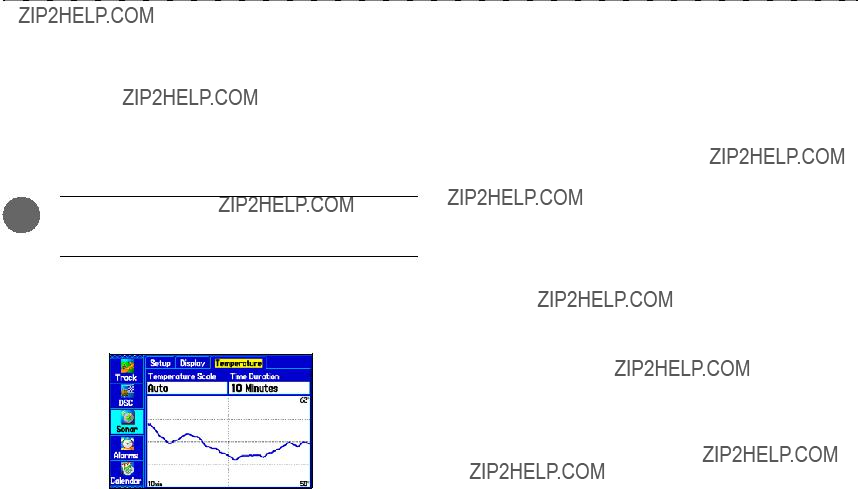
Setting up and Using Sonar > Setting Up Sonar
Viewing the Temperature
Use the Temperature sub tab to view a graph of water temperature changes over a period of time. The graph reads from right to left so that the most recent temperature measured appears on the far right side of the graph. The dotted lines within the graph indicate intervals in the temperature scale and the duration of time. To view temperature information, you must select Temp or Temp, Spd as the transducer type on the Setup sub tab.
Note: You must be receiving proper sonar data from another device, such as Garmin GSD 21 Sounder Module, to view temperature information.
To access the Temperature sub tab:
1.Highlight the Sonar tab on the Main Menu.
2.Select the Temperature sub tab.
Changing the Temperature Display
The graph will adjust and show the temperature changes according to the Temperature Scale and Time Duration settings.
Temperature
Time
Resetting the Temperature Graph
To reset the scale range for the temperature graph, press Menu, highlight Reset Auto Scale, and press Enter. This is useful when the scale spans a large range due to extreme temperature changes. You can reset the scale only when you select Auto for the
Temperature Scale.
To restore the temperature graph to defaults, press Menu, highlight
Restore Default, and press Enter.
Temperature Sub Tab
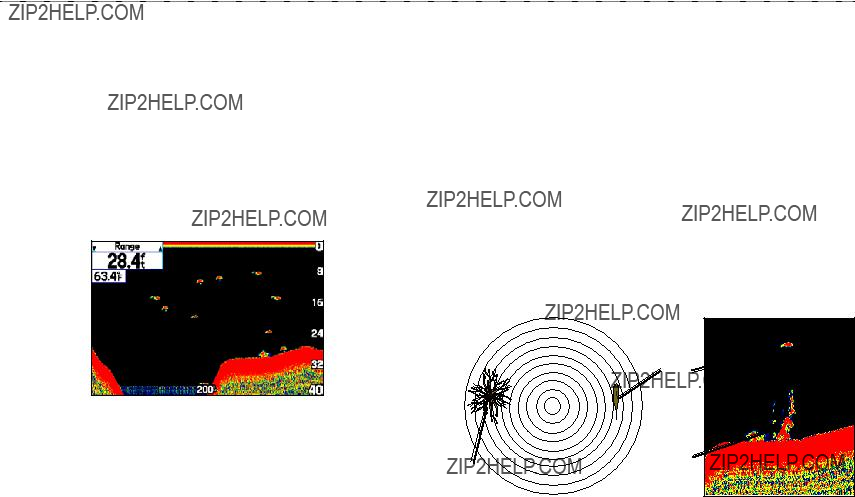
Setting up and Using Sonar > Understanding Sonar
Understanding Sonar
The transducer mounted on your vessel transmits sound waves toward the bottom of the water in a
GPSMAP 378/478 to be processed and shown. The underwater data is shown on the Sonar display in the order that it is returned; first returned is the first on the display.
Understanding the Sonar Display
One of the first things to understand about sonar is that the transducer sends a beam down to the bottom of the water, much like the beam of a flashlight. The beam starts small near your vessel and expands as it gets to the bottom. See ???Transducer Coverage??? for more detailed information.
The Sonar Page does not show a
Sonar Page
Generally speaking, if the only thing between the transducer and the bottom is water, the first strong return comes from the bottom directly below the transducer and sets the bottom level. Weaker secondary returns provide the detailed data. Stronger returns appear in darker colors, with red being the strongest return.

Setting up and Using Sonar > Understanding Sonar
Transducer Coverage
The area covered by the transmitted sound waves is determined by the cone angle of the transducer and the water depth. The wide cone angles (40??) associated with low frequencies (50 kHz) provide a large coverage area for finding fish within a coverage width that is approximately 2/3 of the water depth. However, this also means that wide cone angles produce less bottom detail and resolution. As shown in the drawing on the near right, the 40?? cone angle produces a coverage area of approximately a
The narrow cone angles (10??) associated with high frequencies (200 kHz) provide better bottom resolution and crisper detail, but cannot show a large coverage area for finding fish. The 10?? cone angle provides a coverage width that is approximately 2/10 of the water depth. As shown in the drawing on the far right, the 10?? cone angle produces a coverage area of approximately a
Dual frequency mode combines both frequencies to get the best coverage area and contour/depth readings.
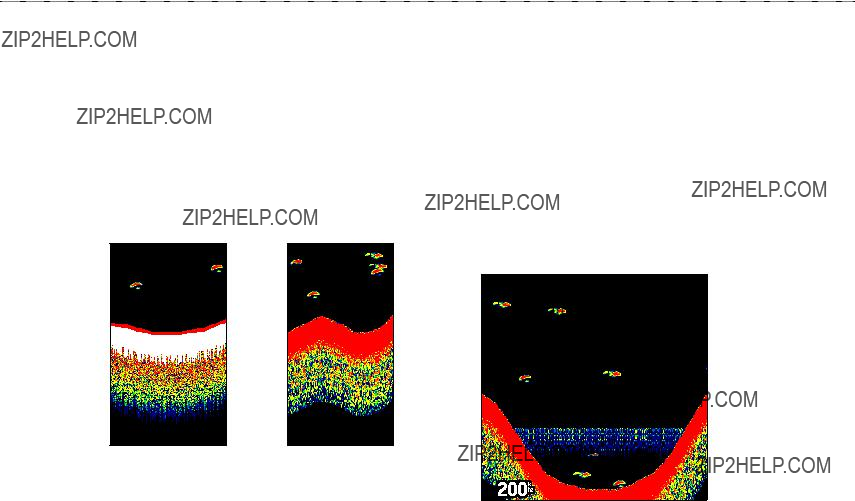
Setting up and Using Sonar > Understanding Sonar
Whiteline
The GSD 21 Sounder Module can help you determine whether the bottom is hard or soft. When the sonar sound waves are reflected back by the bottom, a hard bottom returns a stronger signal than a soft bottom. A thin whiteline indicates a softer bottom, while a thick whiteline indicates a harder bottom. Normally, a red line is used
to show the point where water meets the bottom. This line follows the bottom contour, along with any significant objects lying on the bottom. The unit uses the whiteline function to make the bottom layer information easier to distinguish.
Thick 
Whiteline: Hard
bottom
Thermoclines
A rough definition of a thermocline is a break in water where the water temperature changes faster than the water above it. Thermoclines are shown as the weakest colors.
One of the unique features offered by Garmin is
GSD 21 to ???see??? through thermoclines and helps locate fish where they live.
 Thermocline
Thermocline

Appendix > Specifications
Appendix
Specifications
Physical Specifications
Power
Performance

Appendix > Optional Accessories
Optional Accessories
In addition to the standard accessories included with your GPSMAP 378/478, several optional accessories are available to enhance the operation of the GPSMAP 378/478.
To obtain replacement parts and optional accessories, contact your Garmin Dealer, Garmin Product Support in the U.S.A. at 800/800.1020, or Garmin Europe at 44/0870.8501241.
WARNING: Garmin accessories have been designed and specifically tested for use with Garmin products. Accessories offered by other manufacturers have not been tested or approved for use with Garmin products. Use of such accessories could cause damage to the GPSMAP 378/478 and void the warranty.
GA 29, GA 29F, and GA 26C Antennas: Garmin remote antennas.
GXM 30: The XM antenna. See page 137 for subscription information.
Permanent and Temporary Adhesive Disks: Adhesive disks for using the unit
in a vehicle.
PC Interface Cable: Connects the unit to a serial port on your computer.
Power/Data Cable: Allows you to connect the unit to the electrical system using bare wires.
Programmable Data Cards: Blank data cards available in 16 MB, 32 MB, 64 MB, 128 MB, 256 MB, and 512 MB sizes. Download detailed map data from MapSource
USB Data Card Programmer: Programs blank data cards at high speed through a computer.
Carrying Case: Protects the GPSMAP 378/478 when not in use; has storage space for data cards.
Protective Cover: Snaps on the front of the unit to protect the screen from damage.
MapSource Software

Appendix > Installation Information
Installation Information
This section of the Appendix provides information on connecting the GPSMAP 378/478 to auxiliary devices and removing the antenna.
Connecting the Power/Data Cable
The power/data cable connects the GPSMAP 378/478 to an
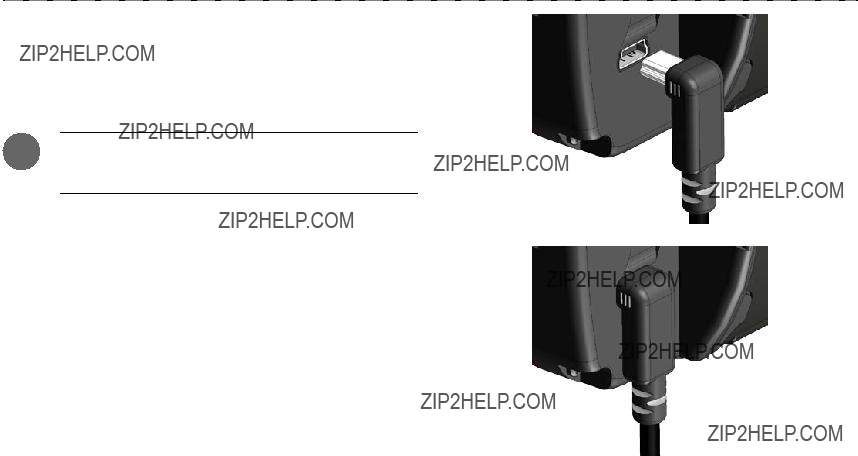
Appendix > Installation Information
Connecting the Optional GXM 30 Antenna
Connect the optional GXM 30 antenna to the GPSMAP 378/478 to access XM WX satellite weather and XM Radio. For more information about the GXM 30 antenna, see the GXM 30 Owner???s Manual.
note: You must subscribe to XM Radio and/or XM WX Satellite Weather to use the XM Radio and/or XM Weather features on your GPSMAP 378/478.
To connect the GXM 30 antenna:
1.Position the antenna where it has a clear view of the sky. This can be on the outside of the vehicle or behind the windscreen.
2.Plug the GXM 30 cable into the USB port on the back of the unit, as shown in the following illustrations.
GXM 30 Antenna Plugged In
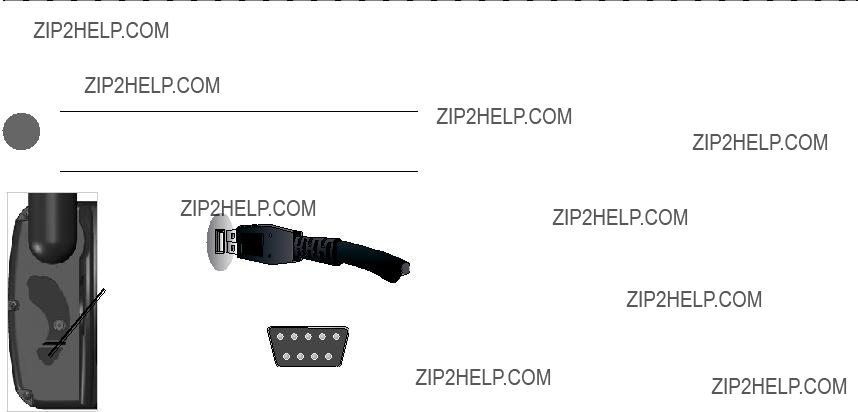
Appendix > Installation Information
Connecting Your GPSMAP 378/478 to a Computer
You can connect your GPSMAP 378/478 to your computer using the supplied USB cable to connect to a USB data port or the
PC Interface cable to connect to a
Note: Fully install the supplied MapSource program, Trip &
Waypoint Manager, on your computer before connecting the USB cable to the computer.
To connect your GPS to your computer:
1.Connect the small end of your cable to the lower connector on the back of the GPSMAP 378/478, shown in the illustration to the left.
2.When using the supplied USB Data Cable, connect the larger end of the cable to an available USB data port (see the illustration on the left).
When using a PC Interface Cable, connect the larger end of the cable to a serial communications port on your computer (see illustration on the bottom left).
Information About USB Drivers
The USB drivers should have been automatically installed when you installed the MapSource program that came with your GPSMAP 378/478. When you initially connect the GPSMAP 378/478 to a USB port, your computer might prompt
you to locate the destination of the drivers for the device. You only need to install the drivers once. After the drivers are installed, your computer will always detect your GPSMAP 378/478 when it is connected. USB drivers might be updated periodically. You can find these updates at www.garmin.com.

Appendix > Installation Information
Using xImage for Customized Waypoint Icons
Use xImage to exchange images between your computer and your GPSMAP 378/478. You can download and save screenshots of any screen shown on your unit. xImage also allows you to download customizable splash screens and waypoint symbols from compatible GPS units, customize them (if you have an image editing program on your computer), and send them back to your GPS unit.
You can download xImage from the Garmin Web site at www.garmin.com/ximage/. See the Help file for complete instructions about using xImage.
Installing and Removing Data Cards
The GPSMAP 378/478 uses an optional Garmin data card to show digital charts and maps. Install the data card in the card slot located on the bottom of the unit. Install or remove the data card at any time, whether the unit is on or off.
You can load a variety of information on your data card, such as MapSource detailed maps. You can also buy preprogrammed cards to use with your GPSMAP 378/478.
Data cards are not waterproof, should not be exposed to moisture or excessive static charges, and should be stored in the case supplied with the card.
To install a data card:
1.Insert the card into the slot on the bottom of the unit. Be sure the label is facing the front of the unit.
2.Firmly push the card into the unit. It is not necessary to force the card. The handle is still exposed when it is properly inserted.
3.If the unit is on, a confirmation tone sounds. The first time you insert a programmed data card, the unit takes a few seconds to read the card. Once the data card has been properly installed and accepted, a summary screen noting the card details appears. Press Enter to acknowledge.
If you insert a data card and get a card format not recognized message, try removing the card and reinserting it. If the card is still not recognized, contact Garmin or your Garmin dealer.
To remove a data card:
1.Grasp the card handle. The handle expands for easy removal.
2.Pull the card out of the card slot on the bottom of the unit.
3.If the unit is on, a confirmation tone sounds when the data card has been removed.
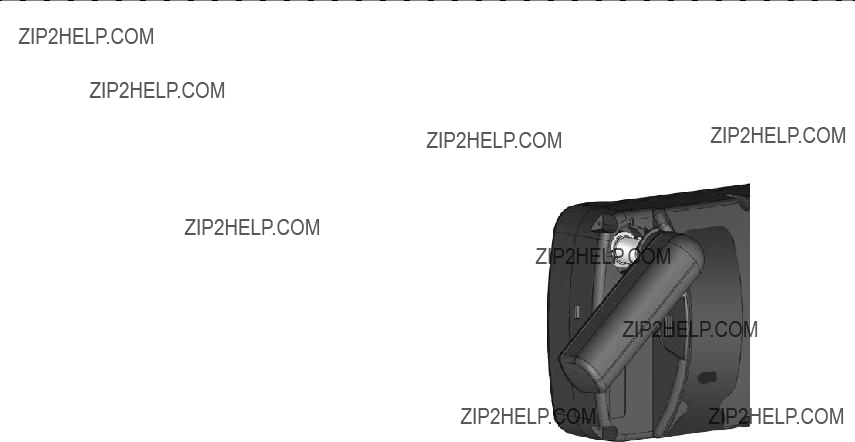
Appendix > Installation Information
Interfacing
The following formats are supported for connection of external devices: GARMIN proprietary Differential GPS (DGPS), NMEA 0180, 0182, 0183 (versions 1.5, 2.0, 2.3, 3.01), ASCII Text Output, and RTCM
The following are the Approved Sentences for NMEA 0183, version 3.01 output: GPRMC, GPGGA, GPGSA, GPGSV, GPGLL, GPBOD, GPRTE, and GPWPL. The following are the Proprietary Sentences for NMEA 0183, version 3.01 output: PGRME, PGRMZ, and PGRMM.
The GPSMAP 378/478 also includes NMEA input with support for the BWC, DBT, DPT, DSC, DSE, MTW, VHW, VTG, and XTE sentences.
Garmin???s proprietary communication protocol is available from the Web site (www.garmin.com).
Removing the GPS Antenna
You can remove the GPS antenna to use an external antenna. After the antenna is removed, the BNC connector is exposed and ready for use with an external antenna. For information on connecting an external antenna to the GPSMAP 378/478, refer to the installation instructions that came with the antenna.
To remove the GPS antenna:
1.Remove the external power cable from the connector on the back of the GPSMAP 378/478.
2.Rotate the antenna to approximately a seven o???clock position. The alignment notches in the casing must line up with the notches on the antenna.
3.Pull the antenna away from the GPSMAP 378/478 unit.
Removing the GPS Antenna

Appendix > Satellite Information
Satellite Information
Inner ring- 45??  above the horizon
above the horizon
Outer ring -
 the horizon
the horizon
45?? 
Satellite Sky View
Satellite Location
The location of each available satellite is shown over two location rings on the Satellite Information Page. The outer ring represents the horizon, the inner ring represents 45?? above the horizon, and the center represents directly overhead. When the unit is using a satellite for navigation, the satellite number is highlighted on the location rings. The unit can show satellite location with North or your current track at the top of the display.
Satellite Strength Indicator Bars
The Satellite Strength Indicator Bars show the strength of the signal being received and the status of the signal. The bars are either shaded or filled. A hollow gray bar means the unit is in the process of storing orbital data it is receiving from the satellite signal. When the bar turns solid green, the unit is using the satellite signal for navigation. A ???D??? in or above the bar means differential corrections (WAAS or DGPS) are being applied to that satellite.
Date, Time, and Current Location
The unit gets date and time information from the satellite???s
What is Differential GPS (DGPS)?
The United States and Canadian governments (among others) have set up Differential GPS (DGPS) stations to transmit correction signals. They are operational in coastal areas and on many navigable river systems.
The DGPS system is available for use without a fee, but you do need additional equipment to receive DGPS signals; a beacon receiver compatible with the RTCM format sentences supported by your Garmin GPS is needed to use DGPS.
Refer to the United States Coast Guard???s Web site (www.navcen.uscg.gov/) for locations and status of the differential stations.
Differential Field
Differential receiver status is indicated in the bottom left field of the GPS tab and will show one of the following conditions:
???
???Searching for

Appendix > Satellite Information
???Using
???Check Beacon
???No Beacon
???Tuning
???Using
???Scanning for
What is WAAS/EGNOS?
The Wide Area Augmentation System (WAAS) is an
The system is made up of satellites and approximately 25 ground reference stations positioned across the United States that monitor GPS satellite data. Two master stations, located on either coast, collect data from the reference stations and create a GPS data correction message.
According to the FAA???s Web site, testing in September 2002, WAAS confirmed an accuracy performance of
WAAS is just one service provider that adheres to the Minimum Operational Performance Standard (MOPS) for global Satellite Based Augmentation Systems (SBAS). Eventually, there will be several services of worldwide geostationary communication satellites and ground reference stations.
All SBAS systems use the same receiver frequency; therefore any operational SBAS system should be capable of providing your GPS unit with increased accuracy at any location in the world.
Currently, enabling WAAS on your Garmin GPSMAP 378/478 in regions that are not supported by ground stations might not improve accuracy, even when receiving signals from an SBAS satellite. In fact, it can degrade the accuracy to less than that provided by GPS satellites alone. For this reason, when you enable WAAS on your Garmin GPS receiver, the receiver automatically uses the method that achieves the best accuracy. To enable WAAS, see page 6.
For more information, go to http://gps.faa.gov.

Appendix > LORAN TD Setup
LORAN TD Setup
LORAN C is a radio navigation aid operated and maintained in the United States by the United States Coast Guard. LORAN
(LOng RAnge Navigation) system covers the entire United States and the U.S. Coastal Confluence Zone. From the perspective of a mariner, the system is used for ocean and coastal navigation. It can be used as a supplemental system for harbor and harbor approach navigation, and it is used for inland navigation by recreational vehicles.
LORAN TD Feature
The LORAN TD (Time Delay) feature eases the transition from using LORAN to using GPS. The GPSMAP unit automatically converts GPS coordinates to LORAN TDs for those who have a collection of LORAN fixes for favorite fishing spots and other waypoints recorded as TDs. You can show your location as a TD or enter waypoints as TDs. The accuracy to be expected from this conversion is approximately 30 meters. When the unit is placed in the LORAN TD format mode, it simulates the operation of a LORAN receiver. Position coordinates might be shown as TDs, and all navigation functions can be used as if the unit was actually receiving LORAN signals.
Using the LORAN TD Format
When creating new waypoints using LORAN TD coordinates, you must set the correct LORAN chain number and secondary stations in the Setup TD field before storing the waypoint. After the waypoint is stored in the unit???s memory, it will always reference the LORAN chain number and secondary stations currently selected in the
Setup TD field. If you enter a different LORAN chain number or change the secondary stations or offsets in the Setup TD field, the active waypoint information will reflect those changes. Because the GPSMAP 378/478 does not rely on the LORAN signal for navigation, it can reference a different GRI chain and/or secondary stations and still navigate to the location stored in memory.
The LORAN Location Format field is located on the Location sub tab of the Setup tab on the Main Menu. The LORAN TD Setup window contains the fields to select the Loran
Primary and Secondary Stations, and TD Offsets.

Appendix > LORAN TD Setup
To set up Loran TD from the Main Menu:
1.Highlight the Setup tab on the Main Menu, and then highlight the Location sub tab.
2.Highlight the Location Format field and press Enter.
Location Sub Tab
3.Highlight Loran TD, and press Enter.
4.Highlight the Setup button located on the right side of the
Location Format field and press Enter. The Loran TD Setup window appears.
5.To change the settings of any of the five fields, highlight the field, press Enter, select a setting, and press Enter again.
LORAN TD Setup
6. When finished, highlight the Save button, and press Enter.
If the active GRI Chain, secondary stations, or offsets were changed since the waypoint was created, the waypoint now references
the active GRI chain and secondary stations and adjusts the TD coordinates accordingly. Remember that the GPS is not relying on the LORAN signal for navigation and actually converts the TD coordinate to a useful latitude and longitude coordinate before storing the waypoint to memory or using it for navigation. Because of this, the unit can navigate to a TD coordinate anywhere in the world.
For more information on LORAN TDs, you can download the
LORAN TD Position Format Handbook from the Garmin Web site.

Appendix > Map Datums and Location Formats
Map Datums and Location Formats
Map Datums are based on a mathematical model of the Earth.
What Are a Map Datums?
A datum is a mathematical model of the Earth that approximates the shape of the Earth and enables calculations to be carried out in a consistent and accurate manner. The datum is physically represented by a framework of ground monuments whose positions have been accurately measured and calculated on this reference surface. Lines of latitude and longitude on a map or chart are referenced to a specific map datum. Every chart has a map datum reference, and you can set the GPSMAP 378/478 to match most of those commonly used.
If you are navigating and comparing the GPS coordinates to a map, chart, or other reference, set the map datum in the GPS unit to the same datum as the map to ensure the most accurate navigation.
What is a Location Format?
Your current location can be viewed on the GPS in the form of coordinates. Because different maps and charts use different location formats, Garmin GPS units allow you to choose the correct coordinate system for the type of map you are using. The most common format is latitude and longitude, which is used by all Garmin units.
You can choose to change the location format to use with other coordinate systems in the Location field of the Setup
For more information about using paper maps with your Garmin unit, refer to Using a Garmin GPS with Paper Land Maps, available for download at www.garmin.com/manuals/ UsingaGarminGPSwithPaperLandMaps_Manual.pdf.

Appendix > Digital Selective Calling (DSC)
Digital Selective Calling (DSC)
DSC uses marine VHF radio GPS technologies to transmit and receive location information. DSC is used by mariners to assist them in two major areas: distress calls and position reporting.
A
An emergency DSC Distress Call allows a vessel in trouble to transmit a substantial amount of information in a single
transmission, or ???call,??? without the need for voice communication. When any nearby rescuer receives the DSC signal, an alarm sounds, and they immediately receive the position of the caller.
The rescuer can then choose to navigate (Go To) the caller???s position to assist or forward the call on to the Coast Guard. When the Coast Guard receives the call, they can immediately access the caller???s information (such as who they are and the type of vessel) in their database while they are in transit to the caller???s location.
Any time a vessel receives a DSC call, the vessel can store that location and quickly navigate to that position using a Go To. This makes DSC a
What is a Maritime Mobile Service Identity (MMSI) Number?
MMSI basically allows a VHF radio to act like a phone. The
For more information regarding MMSI numbers, visit www.navcen.uscg.gov/marcomms/gmdss/mmsi.htm.

Appendix > Digital Selective Calling (DSC)
How Are MMSI Assignments Obtained?
Commercial users, or those who travel outside the United States or Canada, must apply for a ship station license or an amendment to a ship station license. To find out if you require a Ship Station license, visit http://wireless.fcc.gov/marine/fctsht14.html. If your vessel requires licensing by the FCC, you can obtain a MMSI during the application/licensing process when you file FCC Forms 159 and
605.
Federal Users in the United States
Federal users can obtain MMSI assignments from their agency radio spectrum management office. These procedures are currently under review by the National Telecommunications and Information Administration (NTIA).
Users Outside the United States
Users can obtain an MMSI assignment from their telecommunications authority or ship registry, often by obtaining or amending their ship station license.
Users In Canada
Industry Canada is responsible for assigning MMSI numbers to commercial and recreational vessels. Information is available at the following Web site: http://apollo.ic.gc.ca/english/mmsi.html.
How Can Garmin Help You with DSC?
To receive distress calls or position reports, you must have a
For a distress call, press the MayDay button on the VHF radio. The call transmits on an emergency channel with the MMSI number attached to the call, if the receiver has DSC support. Any DSC- equipped mariner (on sea or land) within range can receive the call.
When the GPSMAP 378/478 is connected to a VHF with DSC support, the GPS unit shows a call list, log, and a directory. Basic wiring is required for the Garmin unit and VHF radio to send and receive NMEA data from each other.

Appendix > Messages
Messages
Accuracy
Antenna Shorted to
Approaching
Basemap Failed Unit Needs
Boat Is Not Moving Fast Enough to
Can???t Unlock
Check XM
Database
Deep
Detail Maps Don???t Support
Distress
Drift
Fish
Flash Flood
National Weather Service.
Flood
Weather Service.
Lost Satellite
Marine
Memory
Memory (RAM) Failed Unit Needs
Memory (ROM) Failed Unit Needs
Near Proximity
NMEA Depth is Below
No Diff GPS
No Roads Near

Appendix > Messages
No Roads Near Starting
No DGPS
No Tide Stations for that
None
Off
Route Memory
Route
Route Waypoint Memory
Saving XM Program
Shallow
Sonar Failed Unit Needs
Sunrise, Switching to Day
Thunderstorm
Tornado
Track Already
Track Log
Track Memory
Track
Transducer Disconnected, Sonar Turned
Transfer
USB
User Timer
Water Speed Sensor is Not
Water Temperature
Waypoint Already
Waypoint Memory
XM

Appendix > Data Field Options
Data Field Options
The following list provides a brief description of each data field option. Some of these options are supported only by devices interfaced to your GPSMAP 378/478.
Battery
Course to
Cross
Depth (Marine
Dest
Distance
ETA
ETA
ETE
ETE
Location
Max
Mov Avg
Move
Next
Next
Next

Appendix > Data Field Options
Trip Avg. Speed
Trip Avg. Speed
Trip
Trip Timer
Trip Timer
Ttl Avg
User
Velocity Made
Vertical
Water Speed (Marine
Water Temperature (Marine
Waypoint
Waypoint
XM
XM

Appendix > Software License Agreement and Product Registration
Software License Agreement
BY USING THE GPSMAP 378/478, YOU AGREE TO BE BOUND BY THE
TERMS AND CONDITIONS OF THE FOLLOWING SOFTWARE LICENSE
AGREEMENT. PLEASE READ THIS AGREEMENT CAREFULLY.
Garmin grants you a limited license to use the software embedded in this device (the ???Software???) in binary executable form in the normal operation of the product. Title, ownership rights, and intellectual property rights in and to the Software remain in Garmin.
You acknowledge that the Software is the property of Garmin and is protected under the United States of America copyright laws and international copyright treaties. You further acknowledge that the structure, organization, and code of the Software are valuable trade secrets of Garmin and that the Software in source code form remains a valuable trade secret of Garmin. You agree not
to decompile, disassemble, modify, reverse assemble, reverse engineer, or reduce to human readable form the Software or any part thereof or create any derivative works based on the Software. You agree not to export or
Product Registration
Help us better support you by completing our online registration today. Go to http://my.garmin.com. Keep the original sales receipt, or a photocopy, in a safe place.
Serial Number: ___??? ___??? ___??? ___??? ___??? ___??? ___??? __
Contact Garmin
Contact Garmin Product Support if you have any questions while using your GPSMAP 378/478. In the USA, go to www.garmin. com/support, or contact Garmin USA by phone at (913) 397.8200 or (800) 800.1020.
In the UK, contact Garmin (Europe) Ltd. by phone at 0808 2380000.
In Europe, go to www.garmin.com/support and click Contact Support for

Appendix > Limited Warranty
Limited Warranty
This Garmin product is warranted to be free from defects in materials or workmanship for one year from the date of purchase. Within this period, Garmin will, at its sole option, repair or replace any components that fail in normal use. Such repairs or replacement will be made at no charge to the customer for parts or labor, provided that the customer shall be responsible for any transportation cost. This warranty does not cover failures due to abuse, misuse, accident, or unauthorized alteration or repairs.
THE WARRANTIES AND REMEDIES CONTAINED HEREIN ARE
EXCLUSIVE AND IN LIEU OF ALL OTHER WARRANTIES EXPRESS,
IMPLIED, OR STATUTORY, INCLUDING ANY LIABILITY ARISING
UNDER ANY WARRANTY OF MERCHANTABILITY OR FITNESS
FOR A PARTICULAR PURPOSE, STATUTORY OR OTHERWISE. THIS
WARRANTY GIVES YOU SPECIFIC LEGAL RIGHTS, WHICH MAY
VARY FROM STATE TO STATE.
IN NO EVENT SHALL GARMIN BE LIABLE FOR ANY INCIDENTAL,
SPECIAL, INDIRECT, OR CONSEQUENTIAL DAMAGES, WHETHER
RESULTING FROM THE USE, MISUSE, OR INABILITY TO USE THIS PRODUCT OR FROM DEFECTS IN THE PRODUCT. Some states do not allow the exclusion of incidental or consequential damages, so the above limitations may not apply to you. Garmin retains the exclusive right to repair or replace the unit or software or offer a full refund of the purchase price
at its sole discretion. SUCH REMEDY SHALL BE YOUR SOLE AND
EXCLUSIVE REMEDY FOR ANY BREACH OF WARRANTY.
To obtain warranty service, contact your local Garmin authorized dealer or call Garmin Product Support for shipping instructions and an RMA tracking number. Securely pack the unit and a copy of the original sales receipt, which is required as the proof of purchase for warranty repairs. Write the tracking
number clearly on the outside of the package. Send the unit, freight charges prepaid, to any Garmin warranty service station.
Online Auction Purchases: Products sold through online auctions are not eligible for rebates or other special offers from Garmin. Online auction con???irmations are not accepted for warranty veri???ication. To obtain warranty service, an original or copy of the sales receipt from the original retailer is required. Garmin will not replace missing components from any package purchased through an online auction.
International Purchases: A separate warranty is provided by international distributors for units purchased outside the United States. This warranty is provided by the local
Garmin Corporation
No. 68, Jangshu 2nd Road,
Shijr, Taipei County, Taiwan
Tel. 886/2.2642.9199
Fax 886/2.2642.9099

Appendix > Weather Data Warranty
Weather Data Warranty
THE WEATHER DATA SOFTWARE PRODUCT IS PROVIDED ???AS IS.???
ALL OTHER WARRANTIES, EXPRESSED OR IMPLIED, INCLUDING
ANY WARRANTY OF MERCHANTABILITY OR FITNESS FOR A
PARTICULAR PURPOSE OR OF
EXCLUDED.
USER SAFETY
If you use XM Services it is your responsibility to exercise prudent discretion and observe all safety measures required by law and your own common sense. You assume the entire risk related to your use of the Services. XM and Garmin assume no responsibility for accidents resulting from or associated with use of the Services. Your Radio Service includes traffic and weather information, and you acknowledge that such information is not for ???safety for life???, but is merely supplemental and advisory in nature, and therefore cannot be relied upon as
LIMITS ON OUR RESPONSIBILITY
a) DISCLAIMERS.
EXCEPT AS EXPRESSLY PROVIDED HEREIN, WE MAKE NO
WARRANTY OR REPRESENTATION, EITHER EXPRESS OR IMPLIED,
REGARDING THE RADIO SERVICE. YOUR USE OF THE SERVICE IS
AT YOUR SOLE RISK. THE CONTENT AND FUNCTIONALITY OF
THE SERVICE IS PROVIDED ???AS IS??? WITHOUT ANY WARRANTY
OF ANY KIND, EXPRESS OR IMPLIED. ALL SUCH WARRANTIES
OR REPRESENTATIONS (INCLUDING, WITHOUT LIMITATION, THE
IMPLIED WARRANTIES OF MERCHANTABILITY, FITNESS FOR A
PARTICULAR PURPOSE, TITLE AND
HEREBY DISCLAIMED.
b) LIMITATIONS OF LIABILITY.
WE ARE NOT RESPONSIBLE FOR ANY SPECIAL, INCIDENTAL, OR
CONSEQUENTIAL DAMAGES OR LOSSES RELATING TO THE USE
OF THE RADIO SERVICE, WHETHER BASED ON NEGLIGENCE OR
OTHERWISE. OUR TOTAL LIABILITY TO YOU AND ANY OTHER
PERSONS RECEIVING OUR SERVICES, REGARDLESS OF THE CAUSE,
WILL IN NO EVENT EXCEED THE AMOUNTS THAT YOU HAVE PAID
TO US FOR THE SERVICE THAT YOU RECEIVED DURING THE SIX
(6) MONTH PERIOD IMMEDIATELY PRIOR TO THE SPECIFIC EVENT
THAT GAVE RISE TO THE APPLICABLE DAMAGE OR LOSS. THIS
ALLOCATION OF RISK IS REFLECTED IN OUR PRICES. YOU MAY
HAVE GREATER RIGHTS THAN DESCRIBED ABOVE UNDER YOUR
STATE???S LAWS.

Appendix > XM Satellite Radio Service Agreement
This product was developed using DAFIF???, a product of the National
This product has not been endorsed or otherwise approved by the National
a.Under 10 U.S.C. 456, no civil action may be brought against the United States on the basis of the content of a navigational aid prepared or disseminated by either the former Defense Mapping Agency (DMA), National Imagery and Mapping Agency (NIMA), or the National
b.The DAFIF??? product is provided ???as is,??? and no warranty, express or implied, including, but not limited to the implied warranties of merchantability and fitness for particular purpose or arising by statute or otherwise in law or from a course of dealing or usage in trade, is made by NGA as to the accuracy and functioning of the product.
c.Neither NGA nor its personnel will be liable for any claims, losses, or damages arising from or connected with the use of this product. The user agrees to hold harmless the United States National
XM Satellite Radio Service Agreement
XM Satellite Radio Inc.
Hardware and required monthly subscription sold separately. Subscription fee is consumer only. Other fees and taxes, including a

Appendix > FCC Compliance
FCC Compliance
This device complies with part 15 of the FCC Rules. Operation is subject to the following two conditions: (1) this device may not cause harmful interference, and (2) this device must accept any interference received, including interference that may cause undesired operation.
This equipment has been tested and found to comply with the limits for a Class B digital device, pursuant to part 15 of the FCC rules. These limits are designed to provide reasonable protection against harmful interference in a residential installation. This equipment generates, uses, and can radiate radio frequency energy and may cause harmful interference to radio communications if not installed and used in accordance with the instructions. However, there is no guarantee that interference will not occur in a particular installation. If this
equipment does cause harmful interference to radio or television reception, which can be determined by turning the equipment off and on, the user is encouraged to try to correct the interference by one of the following measures:
???Reorient or relocate the receiving antenna.
???Increase the separation between the equipment and the receiver.
???Connect the equipment into an outlet that is on a different circuit from the GPS unit.
???Consult the dealer or an experienced radio/TV technician for help.
This product does not contain any

Index
Index
A
accessories 116 accuracy alarm 77 acquiring satellites 5 active route page 50, 56
options menu 50 active track tab 34, 37 AC outlet 2
add to route 22, 24, 27, 62 advanced NMEA output setup 94 alarms 85
anchor drag 76 arrival 76 DSC 72, 75 navigation 76 next turn 76 off course 76 persistent 76 sonar 78 system 77 weather 77
alarms tab 76 alerts. See alarms anchor drag 76 antenna 1, 121
append to route 27 arrival alarm 76
ask my preference 87 assign category 30 attention tone 85 AutoLocate 3, 5 automotive mode 56
following a saved route 60 navigating 57
pages
auto arrange 19 average location 28 avoidance button 87 avoids 61, 87
B
backlight 3, 85 basic operation 13 battery
level 2 pack 1, 2
saver mode 86 beeper 85
bug indicator 46
C
cable 117
calculation method 87
calendar tab 78
calibrate water speed 109 cards, data 120
carpool lanes 87 categories
find menu 17 waypoint 30, 31
CDI. See Course Deviation Indicator celestial tab 79
hunt & fish sub tab 82 sun & moon sub tab 81
chain number 125 charging 2
check beacon wiring 124 cigarette lighter adapter 2 cities 17
cleaning iv clear
track log 35 clock alarm 77 color mode 84 compass page 45, 85
marine timer 46 options menu 46 showing/hiding 45
connecting the GXM 30 antenna 118 connecting the power cable 2, 117
county warnings 97 count down 88 course pointer 46 create
category 30 route 20 waypoints 24, 25
current route page 63 custom avoids 61, 87
D
data card 120 information 19, 40 slot 1
data fields changing 39 options 132
date 89 date/time 123
daylight saving time 89 day view 79

Index
delete
category 31 DSC Call 72 track log 35 waypoint 32
depth 89 detour 61
DGPS 92, 93, 123 alarm 77
differential 123, 124
digital selective calling. See DSC direction display 89
display tab 84 distance and speed 89
distress calls 71, 72, 73, 74, 75, 128, 129
drift 78
DSC 71,
E edit
route 21, 22, 23, 60 waypoints 29
editing a waypoint 29 emergency 128 entering data 9
erase track log 35
exits 17
external power source 2 external voltage
alarm 77
F
faster time 87 FCC 128, 129, 138 field 8
find 17 from 17
from a different location 17, 18 menu 15, 19
finding an item
fish symbols 108 flasher 110
following an automotive route 63 forecast map 98
fronts 97 fuel flow 23
G
getting started 1
going to a destination 14
go to
distress call 73 point 14 position report 73
GPS
off/on 5 options 6 page 6 tips 6
GPS Tab 68 GRI Chain 126 GSD 20 103
GSD 20 Sounder Module 103 GXM 30 Antenna 95, 100
connecting 118
H heading 90 highways
avoid 87 highway page 48, 85
hiding/showing 48 options menu 49 page layout 49 setup 49
hunt & fish sub tab 82 hurricanes 96
I
icons 84 identifier 128
information page 19, 43 installation 117 interval 37
invert 50 item details 19
K keypad 7
L
language 85, 86 legs, track 37 lightning 96
limited warranty 135
location format 90, 127 log filter 84
longitude 132 LORAN TD Setup 125 lost satellite reception 5

Index
M
magnetic variation 90 main menu
alarms tab 76 calendar tab 78 celestial tab 79 display tab 84 DSC tab 71 GPS tab 68 message tab 83 points tab 70 route tab 70 setup tab 86 sonar tab 75 track tab 71
weather tab 68,
Man OverBoard. See MOB map datum 127
map orientation 41 map page 38, 64 declutter 43 setup 40
marine mode pages
marine pages
P
page layout 39 highway 49 trip computer 66
page sequence 13 panning the map 38, 42 PC interface cable 119 persistent alarm 76 plan route 23, 50
plan trips 78 point 79
points of interest 17 points tab 70 position data page 51
options menu 51 position mode 38
position report
connector 1, 2 outlet 2
practice mode. See simulator mode project waypoint location 28 proximity
points tab 32 waypoint 33

Index
R
Radio ID 100 recalculating 88 receiver not usable 5 receiver status 5
receive satellite signals 3 receiving a DSC call 73 record tracks 34, 37 reference position 18 reset timer 88
reset trip data 51 review route 21 road routing tab 87 route 22, 79
add points 22, 27 create
leg transition 24 preference 87
route tab 70 RTCM 92, 93
S
sail boat racing timer 46 satellite acquisition 5 satellite location 123 satellite mosaic 96 satellite signals 4 satellite sky view 123
save present location 25 save this route 65
saving the current route 65 saving tracks 35, 36, 37 scanning for beacon 124 scan for a frequency 92 scroll bar 8
searching for WAAS 123 searching the sky 5 search history 18 selecting options 9
serial communications port 119 serial data format 92
serial number 1 setup tab 86
guidance sub tab 88 interface sub tab 91 location sub tab 90 road routing sub tab 87 system sub tab 86 timers sub tab 88
time sub tab 89 units sub tab 89 welcome sub tab 91
set an alarm 76 set date 89
set fuel flow 23 set speed 23 shallow water 78
shorter distance 87 signal strength 5 simulate 6, 86
GPS 5 simulator mode 11
new location 12 starting 12
software license agreement 134 sonar 103,
adjusting
on the map page 103 setting up 108, 110 understanding 112
sonar tab 75 sound tab 85 speaker 85 specifications 115 speed filter 86
split screen, sonar 107 srfc wx tab 97
stop navigation 50 storm cells 96
sun & moon sub tab 81 surface pressure 97 surface winds 97 switch modes 13 system alarms 77
T
temperature 89, 111 text language 86 thermoclines 114 tide
chart 80 information 80 station 17, 80 sub tab 80
time
delay 125 format 89 offsets 127 zone 89
timer 46 toll roads 87
TracBack 14, 37 track
legs 37
log 34, 35, 37 tab 34 TracBack 36, 37
track tab 71 track up 6, 41 transducer 108, 113
trip computer page 51, 66 options menu 66 page layout 66

Index
trip planning 23, 78 tuning beacon 124
turn off recalculation announcement 88
turn unit on and off 3
U
underwater waypoints 107 unit overview 1
unpaved roads 87 usage mode 86 USB 92
connector 1, 119 data cable 119 drivers 119
user points tab 29 UTC 89 UTM/UPS 127
V
VHF 71, 128 via points 62 view details 43 visibility 97 voice language 85 volume 3, 85
W
WAAS 6, 86, 117, 123, 124 warning page 3
water immersion iv water speed 109
calibrating 109 water temp 78 water temperature 97 wave
direction 97 height 97 period 97
waypoint 17, 24 categories 30 create 24 edit 29
information page 19 name 29
projecting 28 proximity 33 reviewing 26 symbol 29 transition to next 24
weather alarms 77 weather data warranty 135 weather information
finding 101
weather tab 68, 96 options menu 99 using 98
week view 79 welcome message 91 whiteline 106, 114
wide area augmentation system. See WAAS
X
xImage 120
XM Audio Page 52 audio on/off 55 favorites 54 hiding/showing 53 options menu 53 scanning channels 55
XM Tab 69
XM WX Weather 95
finding weather information 101 Mrn Wx tab 97
options menu 95 Srfc Wx tab 97 viewing 95 weather tab 96
Z zoom 41

For the latest free software updates (excluding map data) throughout the life of your
Garmin products, visit the Garmin Web site at www.garmin.com.
?? 2009 Garmin Ltd. or its subsidiaries
Garmin International, Inc.
1200 East 151st Street, Olathe, Kansas 66062, USA
Garmin (Europe) Ltd.
Liberty House, Hounsdown Business Park, Southampton, Hampshire, SO40 9RB UK
Garmin Corporation
No. 68, Jangshu 2nd Road, Shijr, Taipei County, Taiwan
www.garmin.com